Top 25 RFP Software in 2025: Which to Use?
Find the best RFP software for your team in 2025. Compare features, pricing, and pros and cons of top 25 tools to accelerate your RFP response processes.
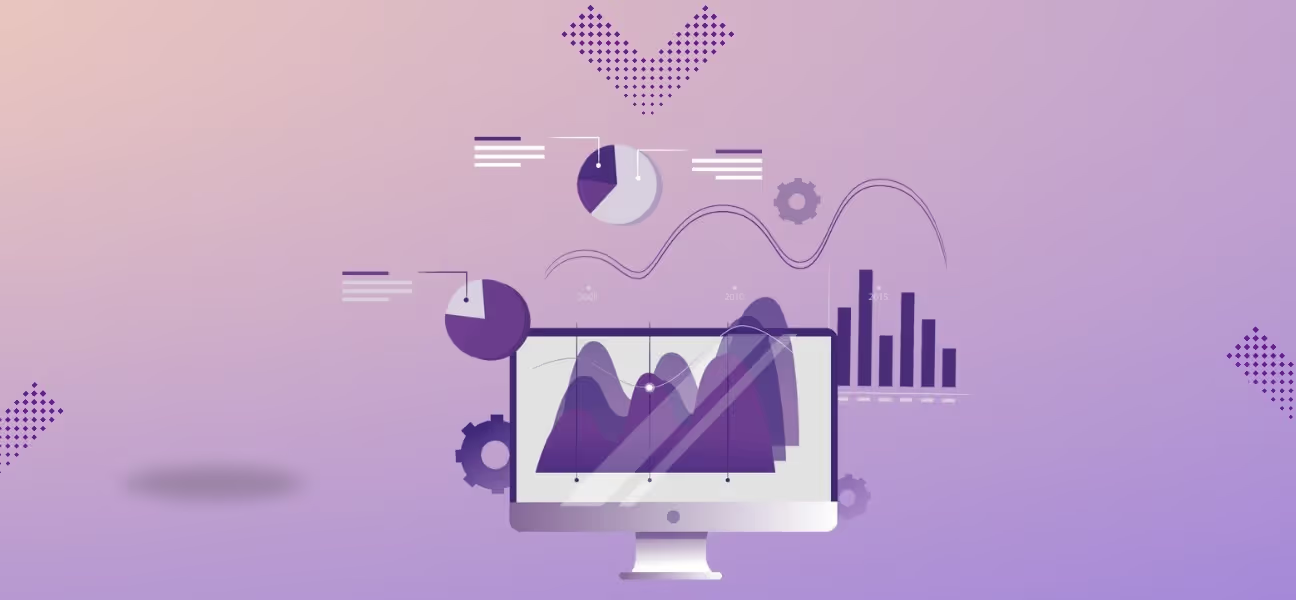
Your sales team spends weeks crafting RFP responses while competitors submit faster, more polished proposals using automated systems.
Revenue leaders now adopt RFP software to speed up proposal development and boost success rates. In fact, HubSpot research shows 78% of sales teams recognize AI helps them focus on their most important work. This just shows why smart automation is crucial for better team performance.
Each RFP software takes a different approach. Some focus on content management, others prioritize collaboration, while advanced solutions provide competitor research and market insights. Your choice depends on whether you need content organization or strategic positioning capabilities for your RFP responses.
In this guide, we break down the top 25 RFP software solutions of 2025, helping you choose the best platform for your team.
TL;DR:
- AI-powered automation reduces RFP response time significantly across leading platforms.
- Centralised content management ensures consistent messaging and removes conflicting information.
- Collaborative workflow features improve team coordination and reduce approval bottlenecks.
- CRM and productivity integrations connect with existing tools for seamless workflows.
- RFP software solutions offer flexible pricing models, ranging from affordable monthly plans to enterprise custom solutions.
What is RFP Software?
RFP software automates proposal creation by building a searchable library from your existing responses. Instead of starting each proposal from scratch, you reuse proven content that already won deals.
For example, without RFP software, your team would search through dozens of files to find last year's security response. With RFP software, they just type "data encryption" and get all relevant responses instantly. The system knows your content and matches it to new questions automatically.
With the right RFP software, your team can handle more RFPs without working longer hours. Response quality also improves because you consistently use your best content instead of recreating answers under tight timeline pressure.
Let’s take a closer look at the top advantages of using RFP software for responding to RFPs.
Benefits of RFP Software
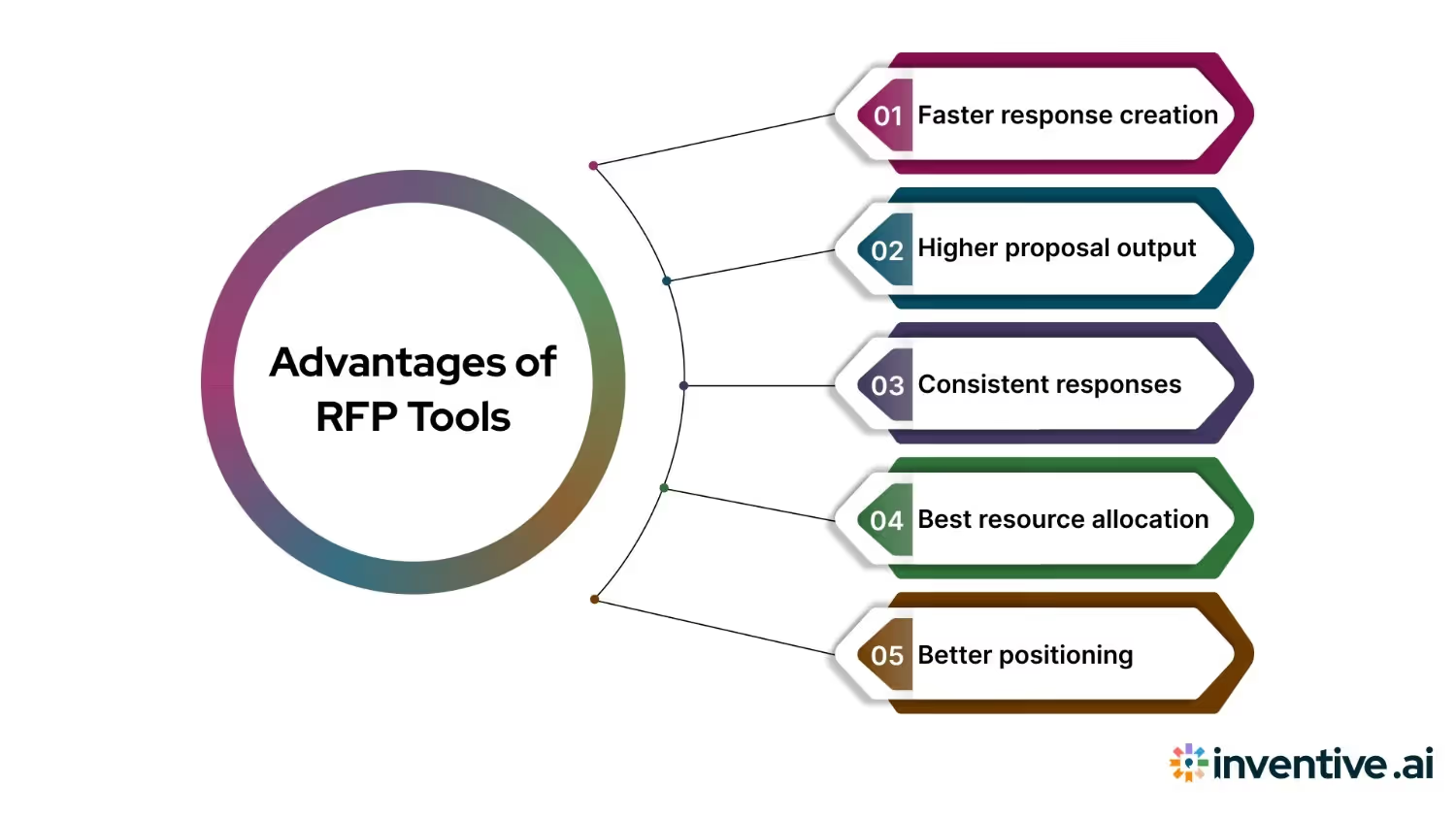
RFP software delivers measurable improvements across your entire proposal operation. These benefits compound over time as your content library grows and your team becomes more efficient at using automated workflows.
The primary advantages organizations experience include:
- Faster response creation: Teams complete proposals in days instead of weeks by reusing proven content and automating routine formatting tasks.
- Higher proposal volume capacity: Organizations can pursue more opportunities simultaneously without hiring additional staff or extending working hours.
- Improved response consistency: All team members access the same approved messaging, eliminating conflicting information and maintaining professional standards across submissions.
- Better resource allocation: Subject matter experts focus on strategic input and differentiation rather than searching for basic company information and recreating standard responses.
- Enhanced competitive positioning: Teams can invest saved time in customer research, competitive analysis, and tailored value propositions that win deals.
Now that you know what RFP software does and its advantages, let’s see how the RFP platforms actually operate to deliver these results.
How Does RFP Software Work?
RFP software operates through several steps to turn your existing content into an automated response system. The platform learns from your successful proposals and applies that knowledge to new opportunities. Here’s how it works:
- Content upload and analysis: You upload previous RFPs and company documents, and the system identifies patterns in your responses and organizes content by topic and question type.
- RFP processing and question matching: When you receive a new RFP, the system reads each question and finds relevant content from your library based on context and keywords.
- Draft response generation: The platform creates initial answers using your existing content, adapting language to match the customer's terminology and requirements.
- Team collaboration and review: The system assigns sections to appropriate team members based on expertise and sends notifications to keep reviews on track.
- Quality checking and submission preparation: The platform identifies inconsistencies between responses and formats everything according to the customer's submission requirements.
This process lets your team focus on strategy and competitive positioning while the software handles content management and workflow coordination.
Now that you know how RFP software works, let's explore the best RFP platforms.
Top 25 RFP Software of 2025: Reviewed and Compared

The RFP software market has evolved significantly, with several AI-powered solutions available to automate RFP response.
Ranking the Best RFP Tools in 2025
Based on recent rankings, user reviews, and expert guides, here are some notable tools:
Let's take a closer look at each solution in detail:
1. Inventive AI
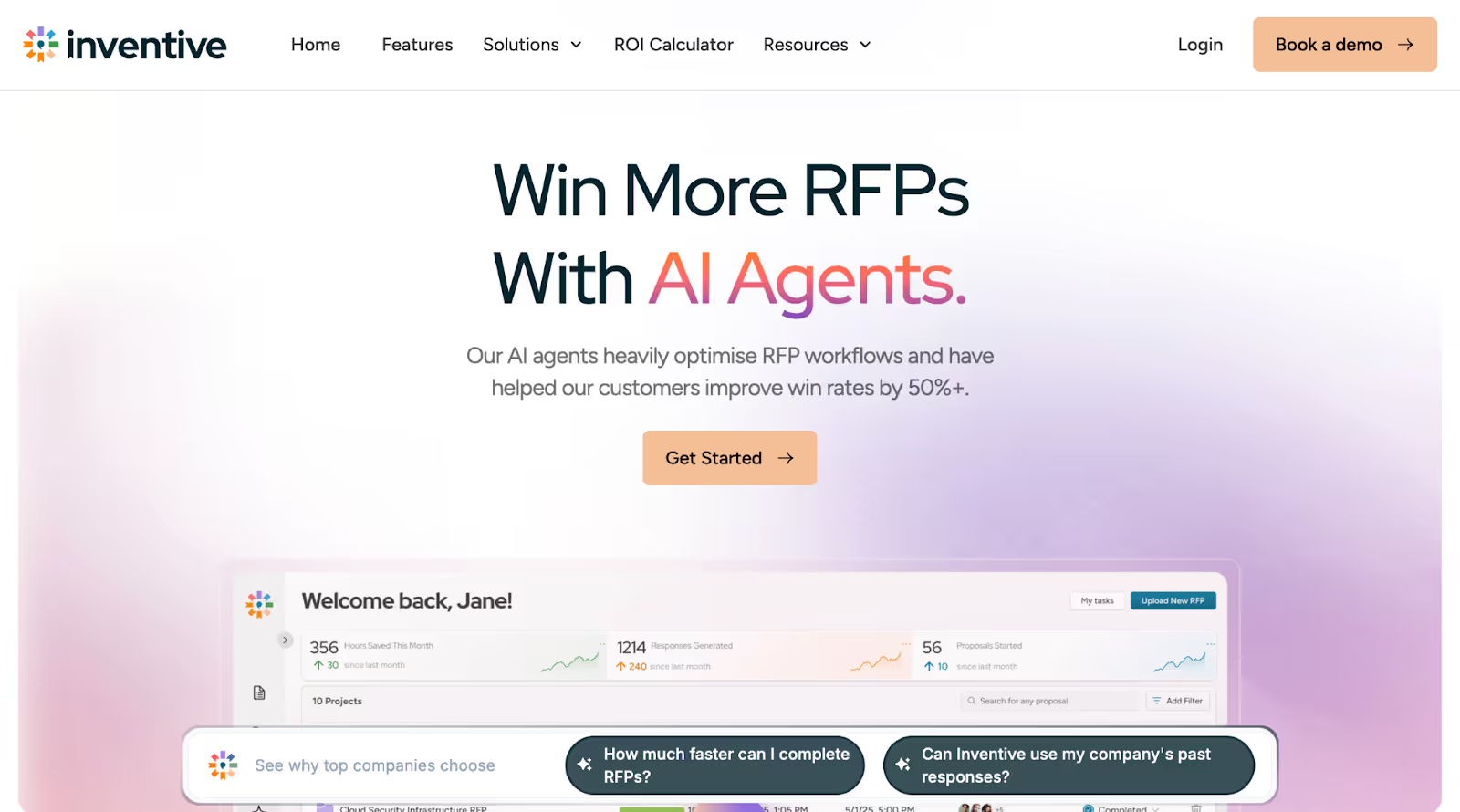
G2 Rating: 5/5
Inventive AI stands out as the most advanced AI-powered RFP response platform, offering specialized AI agents that go beyond basic content generation. The platform combines sophisticated natural language processing with proprietary AI systems designed specifically for RFP response management.
Key Features:
- AI response generation: Teams get accurate first drafts in minutes instead of starting from blank pages, allowing them to focus on customization rather than content creation from scratch.
- Unified knowledge hub: All content from Google Drive, SharePoint, Notion, and previous RFPs becomes instantly searchable in one place, removing the need to check multiple systems for basic company information.
- AI content management: The system automatically flags conflicting information like pricing discrepancies or technical inconsistencies before submission, ensuring professional credibility across all proposals.
- Specialized AI agents: The AI agents research competitors and analyze customer requirements to suggest strategic positioning angles that manual processes can't provide at scale.
- Real-time collaboration: Team members receive notifications and they can track changes instantly, preventing bottlenecks from email-based reviews that slow down timeline-critical submissions.
Pros:
- Advanced AI capabilities: Provide context-aware responses that understand deal specifics and customer requirements.
- Conflict detection: Automatically identifies inconsistencies in proposals before submission.
- Comprehensive integrations: Works with all major platforms, ensuring a smooth workflow.
Cons:
- Learning curve: May require initial training for teams unfamiliar with AI-powered workflows.
- Lots of features: Too many features can be overwhelming for first-time users.
Pricing: Inventive AI offers custom pricing based on team size and feature requirements.
Best Use Cases & Benefits of Inventive AI
- Best RFP software for tracking deadlines and progress: Inventive AI’s real-time collaboration and notification system ensures no submission slips through the cracks. Teams can track every change instantly and stay aligned on timeline-critical tasks.
- Best RFP software with Salesforce or CRM integration: Inventive AI integrates smoothly with major CRMs like Salesforce, HubSpot, and others, helping sales and proposal teams sync customer data directly into responses.
- Best RFP software with strong customer support: Beyond AI automation, Inventive AI backs users with responsive onboarding, training, and ongoing support, ensuring teams get maximum value without disruption.
- Benefits for small and medium businesses: SMBs often lack large proposal teams—Inventive AI acts as an extension of their workforce, automating first drafts, managing knowledge, and reducing time to submit without heavy overhead costs.
- Best RFP software for team collaboration: The platform’s collaboration layer allows proposal managers, subject matter experts, and sales teams to co-edit, review, and finalize responses in real time, cutting out bottlenecks from endless email threads.
- Best RFP software for managing global teams: Whether teams are spread across time zones or working asynchronously, Inventive AI provides a unified knowledge hub and instant updates, keeping everyone aligned without delays.
- Best RFP software for enterprises: Large organizations benefit from enterprise-grade security, compliance readiness, and integrations with knowledge systems like SharePoint, Google Drive, and Notion, making Inventive AI scalable at the enterprise level.
- Best RFP software for long-term scalability: As companies grow, so does their proposal complexity. Inventive AI scales with the organization—supporting more data sources, larger teams, and advanced AI agents that continuously improve response quality.
Companies using Inventive AI report significant improvements in both speed and quality. Here’s what others say about Inventive AI:
"Thank you for building this tool. I am so pumped. Overall, my RFP workflow is SO much faster now with Inventive. My day was a lot less stressful using Inventive."
— Anthony Pukal, Solutions Consultant
2. Loopio
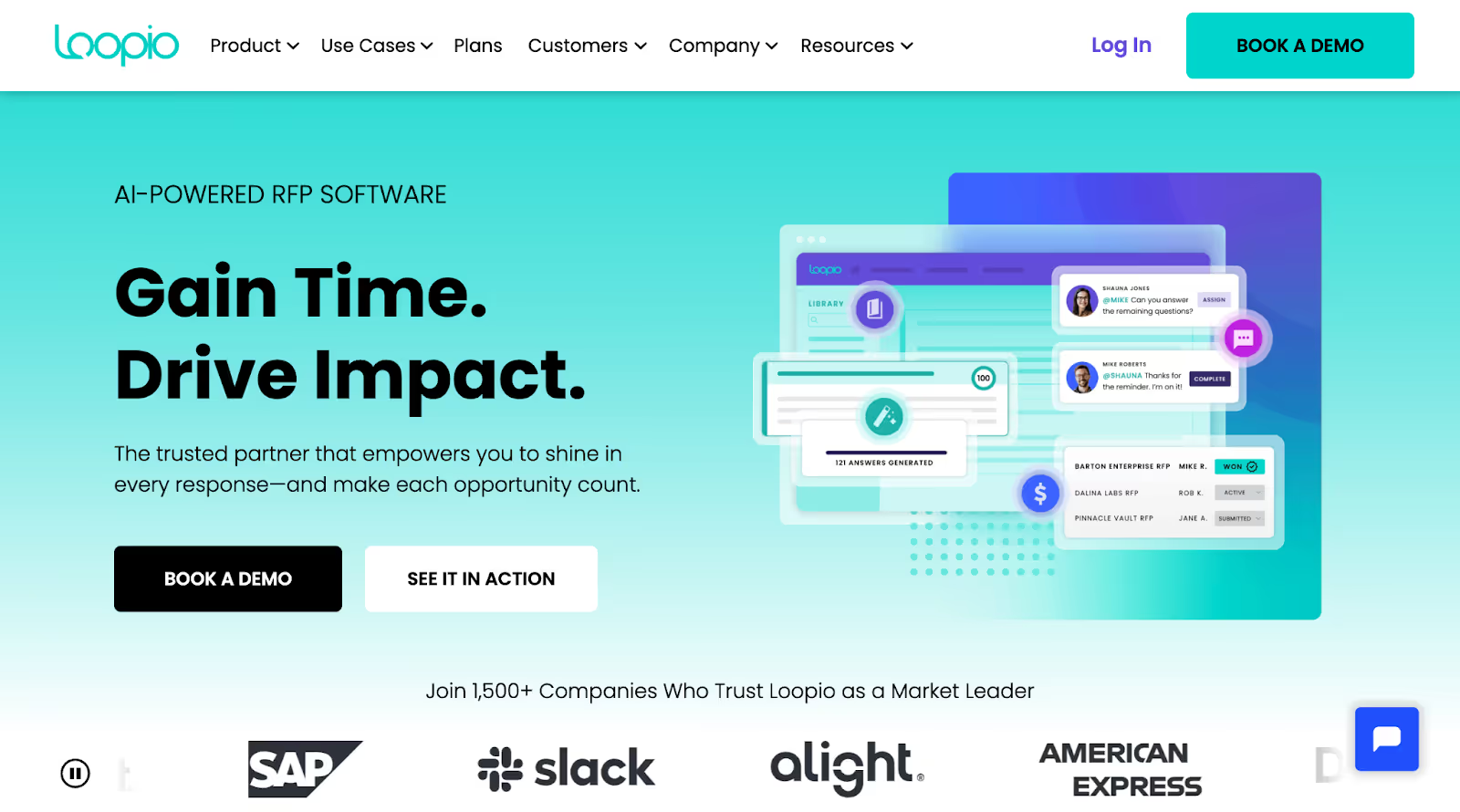
G2 Rating: 4.7/5
Loopio has established itself as a market leader in RFP response management, serving over 1,500 companies with its comprehensive content management approach. The platform emphasizes trust, security, and scalability for enterprise teams.
Key Features:
- Intelligent automation: Streamlines repetitive tasks while maintaining human oversight and control.
- Enhanced library management: Organizes content across multiple product lines, geographies, and languages.
- Advanced collaboration: Enables multi-step reviews and approvals with customizable workflows.
- Go/no-go functionality: Helps teams make strategic decisions about which opportunities to pursue.
- Generative AI integration: Assists with content creation while maintaining enterprise security standards.
Pros:
- Mature platform: With extensive feature set and proven track record across industries.
- Strong security: Meets enterprise requirements with comprehensive compliance certifications.
- Excellent support: Provides award-winning customer service and extensive training resources.
Cons:
- Complex setup: May require significant time investment for initial configuration and content migration.
- Feature complexity: Can overwhelm smaller teams who need simpler, more focused solutions.
Pricing: Loopio offers tiered pricing plans designed to scale with business growth:
- Essentials: Covers basic project management and content library features.
- Plus: Adds enhanced library management and CRM integrations.
- Advanced: Includes multi-language support and advanced collaboration tools.
- Enterprise: Provides custom solutions for large organizations with complex needs.
Best For: Loopio works best for established enterprises with dedicated proposal teams who need comprehensive content management and robust collaboration features. The platform suits organizations handling high volumes of RFPs across multiple business units.
3. Responsive
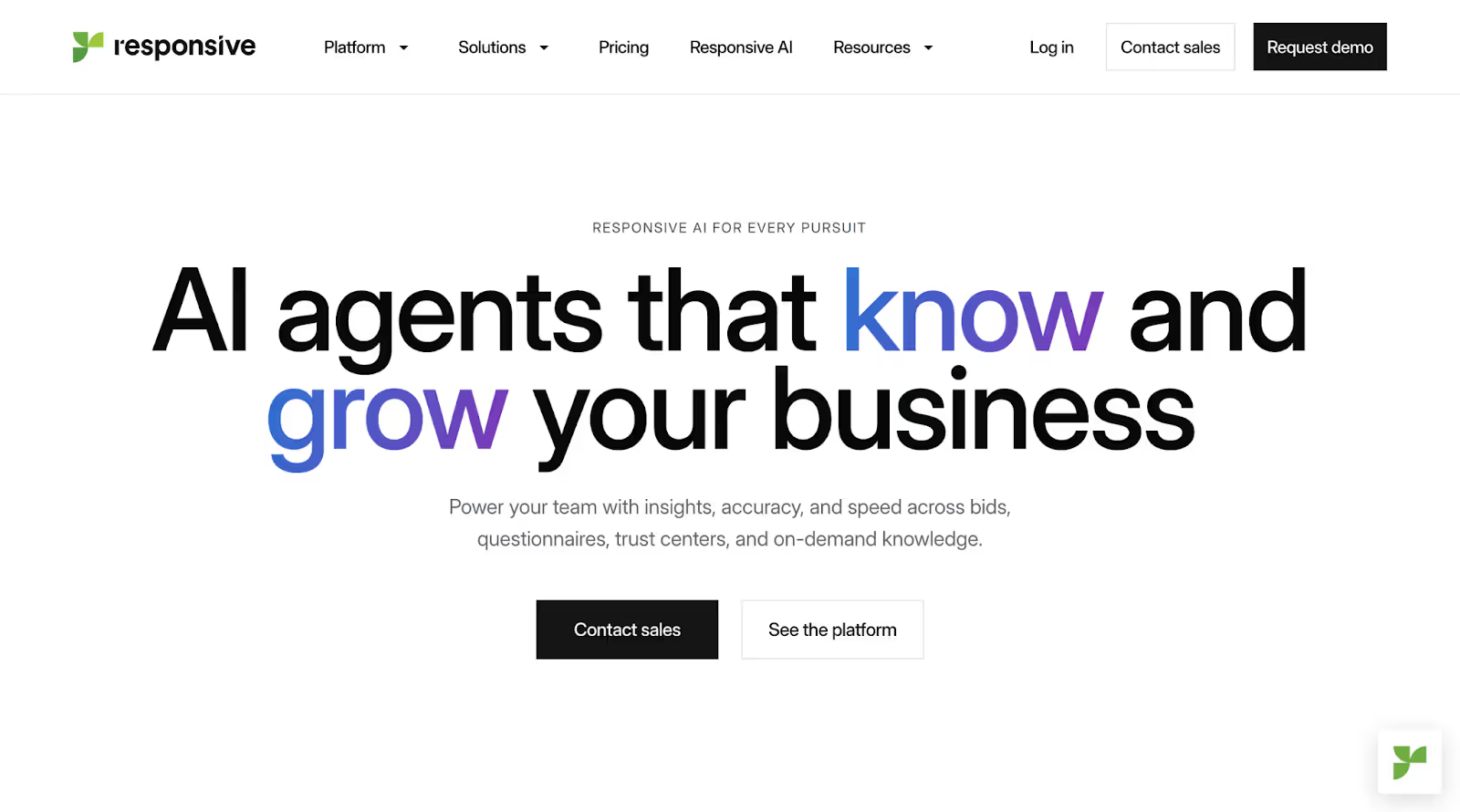
G2 Rating: 4.5/5
Responsive positions itself as the strategic response management platform, focusing on business intelligence and process optimization. The company serves over 2,000 organizations globally, managing more than $750 billion in opportunities.
Key Features:
- Response projects: Manage content and collaboration for bids and proposals with workflow automation.
- Requirements analysis: Helps teams quickly determine whether RFPs align with company capabilities.
- Profile center: Creates pre-filled documents that can be securely shared with prospects.
- Lookup functionality: Provides field teams with instant access to company knowledge.
- Proposal builder: Gives sellers confidence with branded, accurate proposal templates.
Pros:
- Strategic focus: Goes beyond automation to provide business intelligence and process insights.
- Extensive integrations: Connect with leading CRM, productivity, and collaboration platforms.
- Proven results: Customers report significant ROI improvements and time savings.
Cons:
- Learning curve: Requires training to fully utilize strategic features and analytics.
- Premium pricing: Reflects enterprise focus but may exceed smaller team budgets.
Pricing: Responsive offers three main editions tailored to different organization sizes:
- Emerging Edition: For smaller businesses up to 50 employees.
- Growth Edition: For expanding businesses up to 500 employees.
- Enterprise Edition: For large organizations with complex requirements.
Best For: Responsive excels with revenue teams that need strategic insights alongside proposal automation. The platform works well for organizations focused on optimizing their entire response process, not just individual proposals.
4. Qvidian
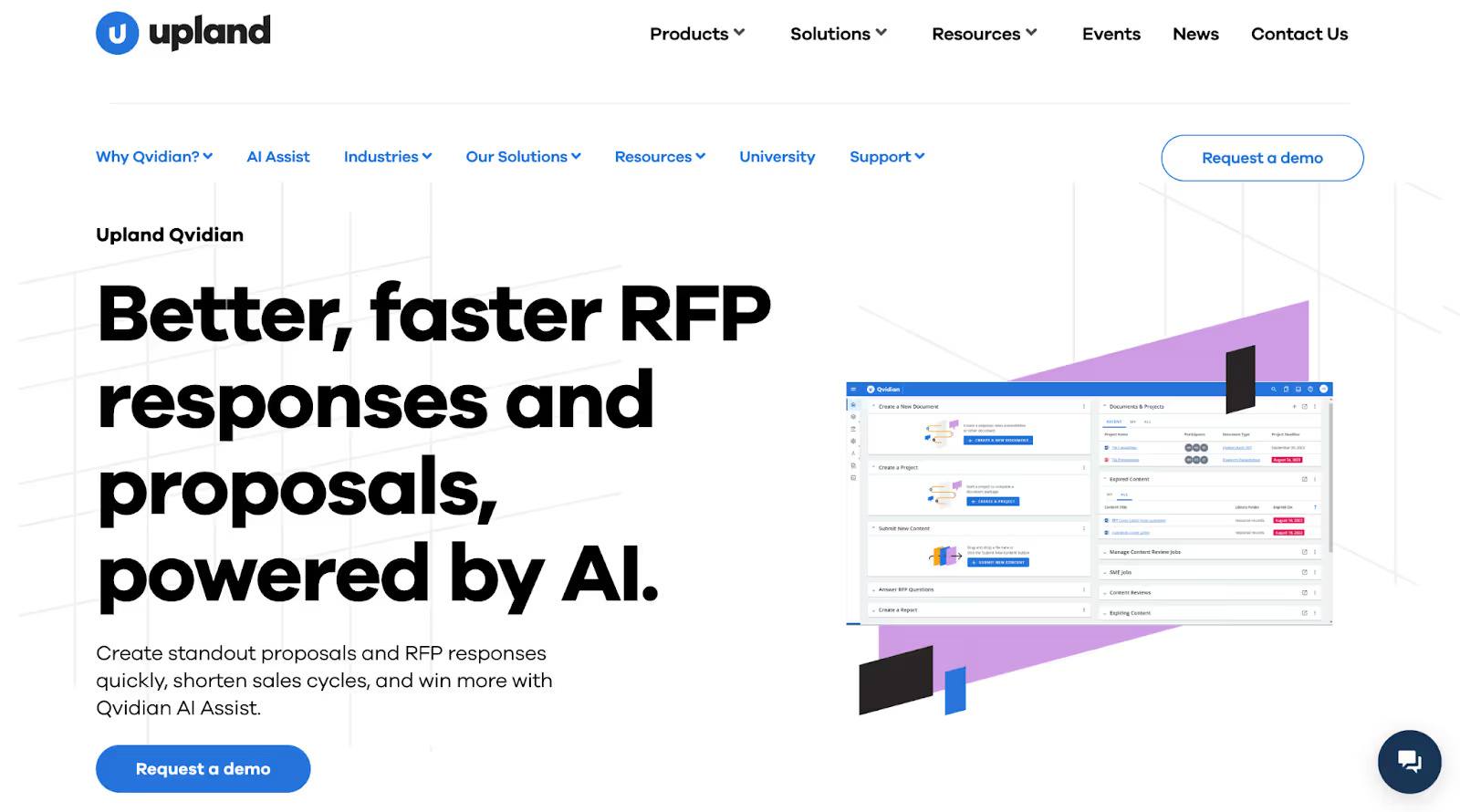
G2 Rating: 4.3/5
Qvidian brings nearly 50 years of industry experience to proposal automation, offering AI-powered features built specifically by proposal experts. The platform focuses on serving professional services and enterprise clients.
Key Features:
- Industry-pioneering automation: Automatically answers questions and suggests relevant responses.
- AI Assist functionality: Generates and revises responses with superior generative AI capabilities.
- Central content library: Manages all content with user-friendly, customizable organization.
- Virtual team collaboration: Includes in-product messaging and industry software integrations.
- Professional templates: Easily format documents and enforce brand standards.
Pros:
- Deep expertise: Combines decades of proposal experience with modern AI capabilities.
- Comprehensive features: Covers the entire proposal lifecycle from creation to submission.
- Strong analytics: Provides 70+ reports and custom drag-and-drop report builder.
Cons:
- Traditional approach: May feel less innovative compared to newer AI-first platforms.
- Enterprise focus: May not suit smaller teams seeking simpler, more agile solutions.
Pricing: Qvidian uses custom pricing based on organizational needs and feature requirements. The platform typically serves mid-market and enterprise clients with comprehensive proposal operations.
Best For: Qvidian works best for established organizations with formal proposal processes who value proven methodologies and extensive feature sets. The platform suits professional services firms and enterprises with complex compliance requirements.
5. Proposify
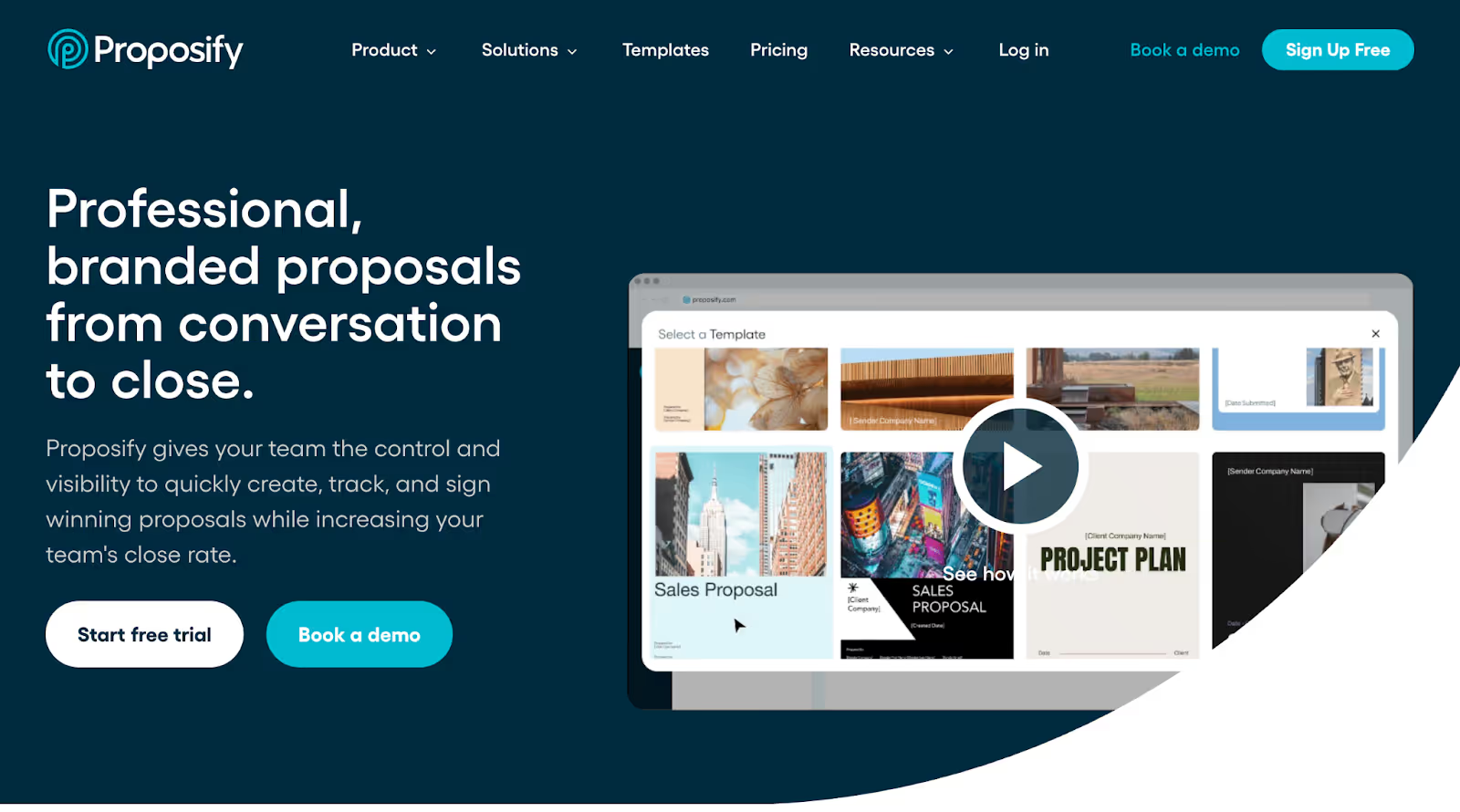
G2 Rating: 4.6/5
Proposify focuses on visual proposal design and client experience, helping teams create professional, branded documents that stand out from competitors. The platform emphasizes ease of use and quick implementation.
Key Features:
- Document automation: Accelerates sales cycles with professional, on-brand templates.
- Interactive quotes: Create error-free pricing proposals with built-in calculation tools.
- Contract management: Enables markup and signing for quotes, agreements, and contracts.
- E-signatures and payments: Streamline the final stages of deal closure.
- CRM integration: Pulls data directly from sales systems to eliminate manual entry.
Pros:
- Visual focus: Creates impressive, professional-looking proposals that enhance brand perception.
- Quick implementation: Gets teams up and running faster than complex enterprise platforms.
- Transparent pricing: Offers clear, predictable costs with flexible plan options.
Cons:
- Limited AI features: Focuses more on design than advanced automation capabilities.
- Proposal-centric: May not handle complex RFP response workflows as effectively.
Pricing: Proposify offers three main pricing tiers with annual discounts:
- Basic: At $19/user/month (annually), includes core proposal creation and e-signature features.
- Team: At $41/user/month (annually), adds integrations and collaboration tools.
- Business: At $65/user/month (annually) provides advanced workflows and API access.
Best For: Proposify works best for sales teams that prioritize visual presentation and client experience over complex RFP automation. The platform suits smaller teams and service-based businesses that need professional proposals quickly.
6. AutoRFP ai
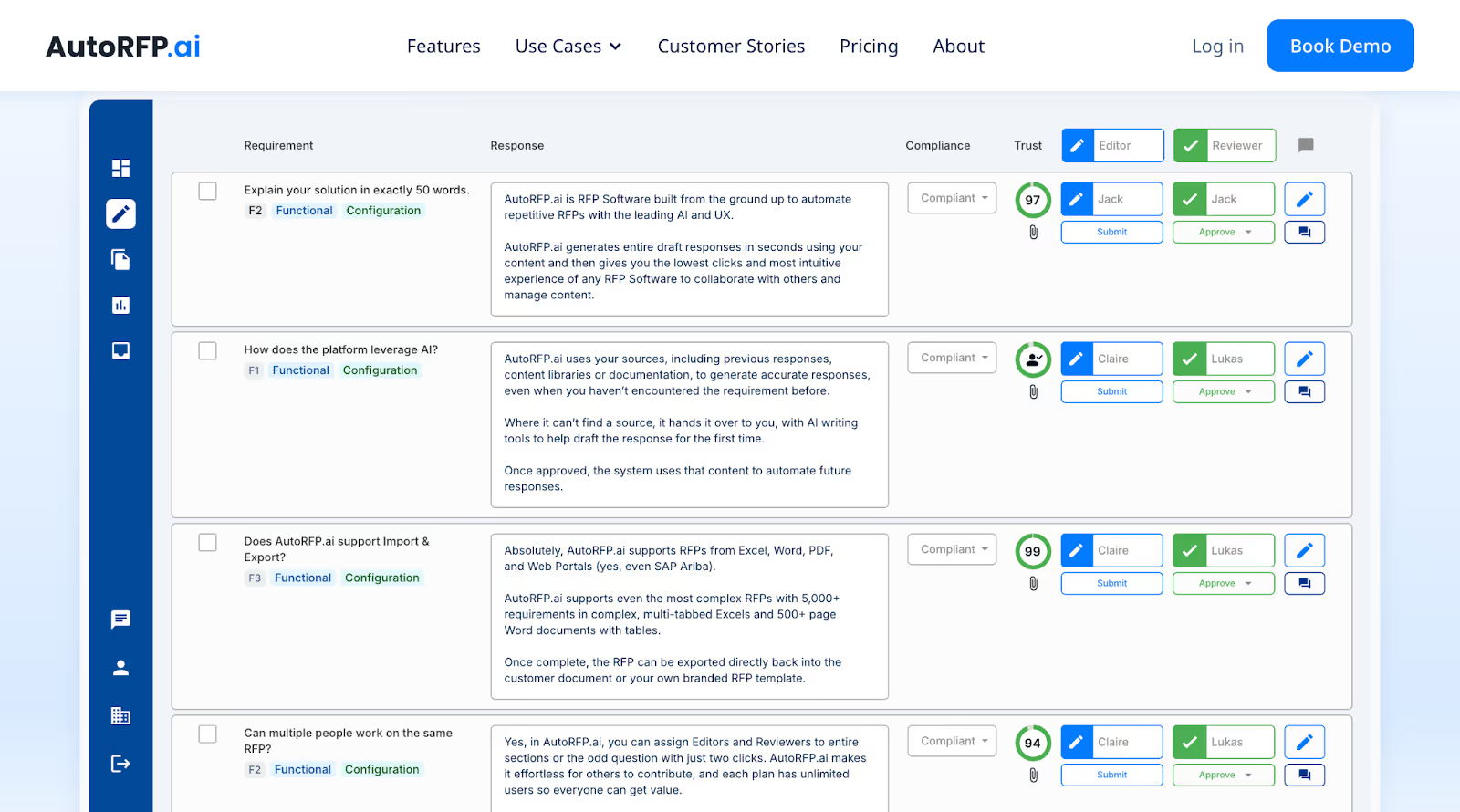
G2 Rating: 4.9/5
AutoRFP ai positions itself as RFP software "reimagined" with ground-up AI development rather than adding AI features to existing platforms. The platform emphasizes user experience and global scalability.
Key Features:
- Instant AI responses: Generate complete draft responses in seconds using your existing content.
- Real-time collaboration: Enables unlimited users with intuitive assignment and review workflows.
- Multi-language support: Automatically translates responses into 30+ languages and localizations.
- Private AI security: Processes confidential data with Azure AI while maintaining data sovereignty.
- Comprehensive integrations: Connect with Salesforce, Slack, Google Drive, and other business tools.
Pros:
- Modern architecture: Built specifically for AI-powered workflows rather than retrofitted features.
- Unlimited users: On all plans eliminates licensing concerns for growing teams.
- Global capabilities: Support international operations with automatic translation features.
Cons:
- Newer platform: May lack some advanced features found in more established solutions.
- Project-based pricing: May become expensive for teams handling high volumes of RFPs.
Pricing: AutoRFP ai offers usage-based pricing with all features included:
- Scale: At $1,000/month for 24 projects per year with unlimited AI and users.
- Accelerate: At $1,450/month for 50 projects per year with full feature access.
- Enterprise: Provides flexible pricing for organizations with higher volume needs.
Best For: AutoRFP ai works well for growing teams that need modern AI capabilities without complex enterprise features. The platform suits organizations with international operations or multi-language requirements.
7. 1up

G2 Rating: 4.9/5
1up focuses on knowledge automation and sales enablement, helping teams quickly access company information across multiple use cases beyond just RFPs. The platform emphasizes broad knowledge management capabilities.
Key Features:
- Knowledge automation: Connects company websites, Google Drive, Confluence, and other sources into a unified system.
- Questionnaire automation: Generates hundreds of RFP and security questionnaire responses in minutes.
- Sales enablement: Provides instant answers in Slack, Teams, and Google Chat for ongoing support.
- Browser plugin: Enables automation directly within web-based questionnaire portals.
- Trust hub: Creates customer-facing portals for compliance and security information.
Pros:
- Broad application: Serves multiple use cases beyond RFPs, including sales enablement and customer support.
- Quick setup: Gets teams productive faster than complex enterprise platforms.
- Competitive pricing: Offers good value for comprehensive knowledge automation capabilities.
Cons:
- General focus: May not provide specialized RFP features that dedicated platforms offer.
- Limited customization: Compared to enterprise solutions with extensive configuration options.
Pricing: 1up offers straightforward pricing with unlimited collaborators and all features:
- Starter: At $300/month for 2 admin users and 12 questionnaires annually.
- Plus: At $500/month for 5 admin users and 30 questionnaires annually.
- Pro: At $850/month for 10 admin users and 60 questionnaires annually.
- Enterprise: Provides custom pricing for larger organizations with higher volumes.
Best For: 1up works best for teams that need knowledge automation across multiple functions, not just RFP responses. The platform suits organizations where sales teams frequently field questions about products, processes, and company information.
8. QorusDocs
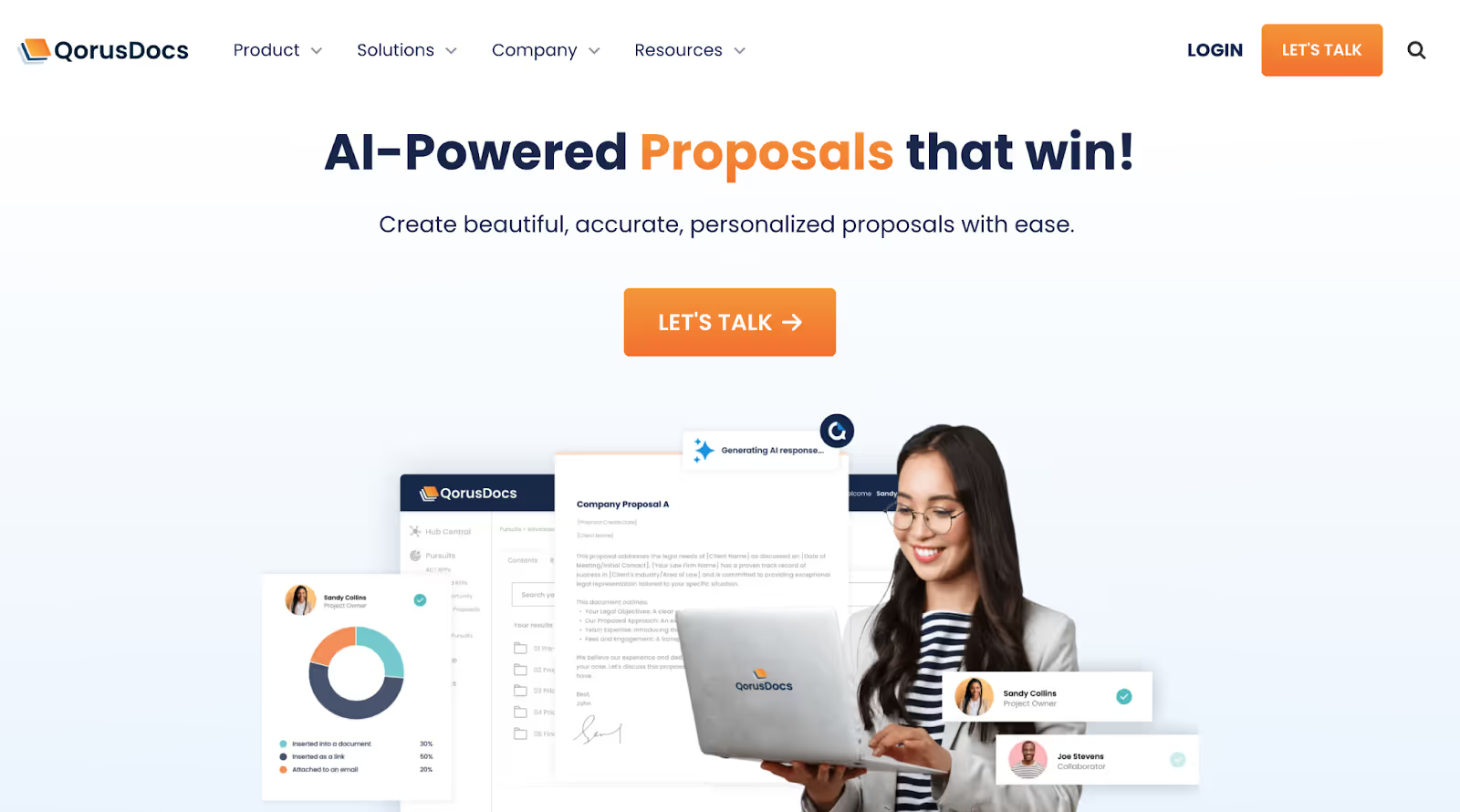
G2 Rating: 4.4/5
QorusDocs specializes in Microsoft Office integration, providing proposal management capabilities that work natively within familiar productivity tools. The platform targets teams already invested in Microsoft ecosystems.
Key Features:
- Microsoft integration: Works directly within Word, PowerPoint, Excel, and Outlook for seamless workflows.
- AI-powered proposals: Creates accurate, personalized proposals with automated content suggestions.
- Collaborative workflows: Enable real-time team input and approval processes within Office applications.
- Template management: Maintains brand consistency across proposals with automated formatting.
- CRM connectivity: Integrates with Salesforce, Dynamics 365, and other sales platforms.
Pros:
- Native integration: Eliminates the need to learn new interfaces or change existing workflows.
- Familiar environment: Leverages Microsoft Office skills that teams already possess.
- Industry focus: Provides specialized solutions for legal, professional services, and AEC firms.
Cons:
- Microsoft dependency: Limits flexibility for teams using other productivity platforms.
- Limited AI features: Compared to platforms built specifically for AI-powered automation.
Pricing: QorusDocs uses custom pricing based on organizational needs and Microsoft Office integration requirements.
Best For: QorusDocs works best for organizations heavily invested in Microsoft Office who want proposal capabilities without changing their existing workflows. The platform suits professional services firms and enterprises with established Office-based processes.
So, we have explored all the top RFP platforms. But it’s also essential to know about the top factors to look for while choosing the best software for your organization.
9. XaitPorter
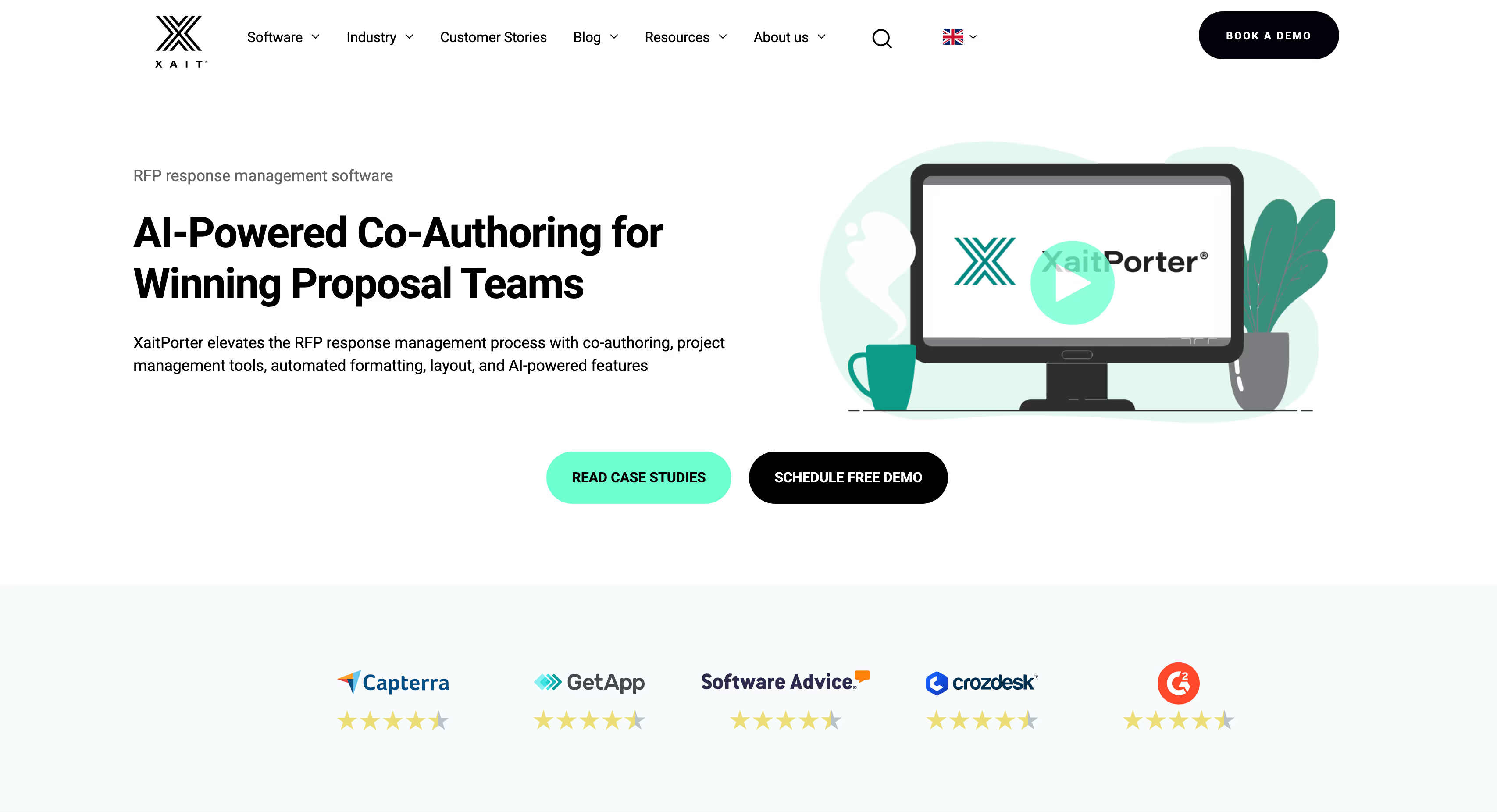
G2 Rating: 4.6/5
XaitPorter is a collaborative proposal management software designed for complex, high-stakes bids and tenders. It focuses on structured document automation, compliance, and real-time co-authoring, making it ideal for industries like engineering, oil & gas, legal, and professional services.
Key Features:
- Structured document assembly: Allows multiple contributors to work in a single document with role-based access and locked formatting.
- Co-authoring in real time: Enables simultaneous collaboration without version control issues.
- Built-in compliance checks: Ensures adherence to corporate branding, formatting, and regulatory requirements.
- Integrated workflow engine: Automates reviews, approvals, and notifications.
- Audit-ready history: Tracks all contributions, edits, and comments for transparency.
Pros:
- Strong compliance controls: Great for industries with strict documentation standards.
- No formatting worries: Formatting is handled centrally, allowing users to focus on content.
- Multi-language support: Helps global teams collaborate seamlessly.
Cons:
- Not AI-first: Lacks native generative AI features for content suggestion or automation.
- Design flexibility: Limited customization in template design compared to proposal-centric platforms.
Pricing:
XaitPorter offers custom pricing based on user roles, document volume, and support needs. Enterprise deals typically include onboarding, training, and dedicated customer success resources.
Best For:
XaitPorter is best suited for large, document-heavy enterprises needing rigorous compliance and structured workflows, especially in regulated or technical industries like engineering, energy, and legal services.
10. RFP360
G2 Rating: 4.5/5
RFP360 streamlines both RFP creation and response, making it a versatile tool for buyers and sellers. With its dual-sided functionality, it enables organizations not just to respond to RFPs but also to issue and manage them effectively—offering a full lifecycle RFP management solution.
Key Features:
- End-to-end RFP lifecycle: Supports both issuing and responding to RFPs from a single interface.
- AI-assisted responses: Suggests content based on previous answers and improves over time through machine learning.
- Content library with performance insights: Tracks how often content is used and how effective it is in winning deals.
- Real-time collaboration and tracking: Assign tasks, set deadlines, and monitor response progress.
- RFP creation tools: Build templates, question sets, and evaluation workflows to streamline outbound RFPs.
Pros:
- Dual functionality: One of the few platforms supporting both issuers and responders.
- Clean, intuitive UI: Easy to learn for both procurement teams and sales professionals.
- Improves over time: AI suggestions become more accurate as usage increases.
Cons:
- Best features gated behind higher tiers: Full AI capabilities and analytics require premium plans.
- Not built for very large enterprises: May lack scalability for organizations with hundreds of concurrent RFPs.
Pricing:
RFP360 offers tiered pricing based on the number of users and features. Typical packages include:
- Basic: Ideal for small teams managing a few RFPs per quarter.
- Professional: Includes advanced analytics and AI features.
- Enterprise: Designed for large teams with both issuing and response workflows.
Best For:
RFP360 is ideal for mid-sized companies that both issue and respond to RFPs and want a centralized, intuitive platform. It's especially helpful for procurement and sales teams seeking better alignment and full-cycle visibility.
11. Expedience Software
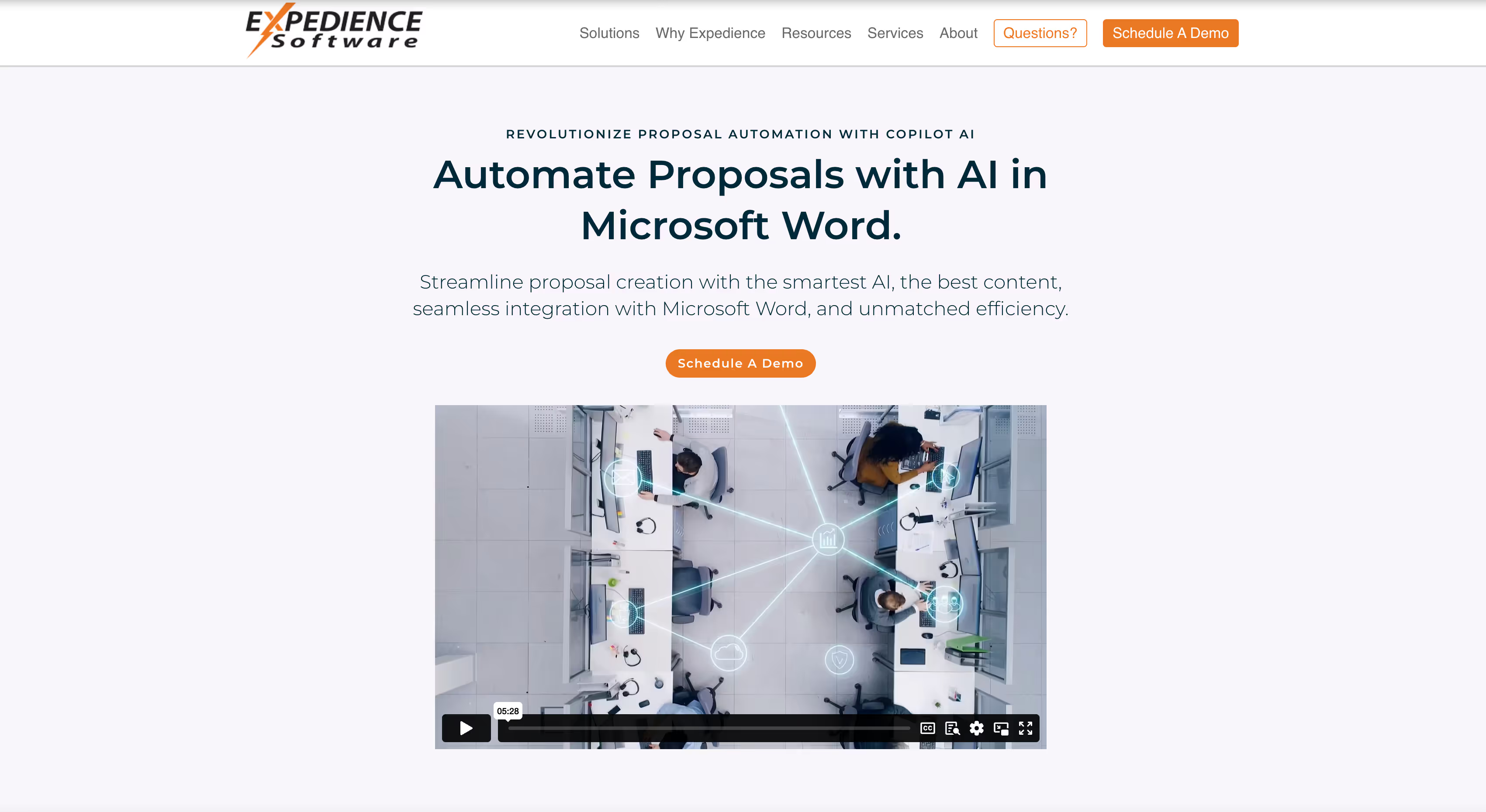
G2 Rating: 4.7/5
Expedience Software delivers proposal automation directly within Microsoft Word, providing a familiar, low-friction environment for proposal teams. Designed for professional services and highly regulated industries, it emphasizes control, compliance, and formatting precision over complex AI-driven features.
Key Features:
- Microsoft Word integration: Works entirely within Word, allowing users to build proposals without switching platforms.
- Reusable content libraries: Organize and insert branded content, graphics, and boilerplate sections with ease.
- Custom styling & formatting tools: Enforce brand standards across all proposals automatically.
- Smart automation: Automates repetitive tasks like table generation, document structures, and disclaimers.
- No cloud required: Offers a locally hosted option for organizations with strict IT or data security policies.
Pros:
- Familiar workflow: No steep learning curve for users already comfortable with Microsoft Word.
- High compliance control: Ideal for industries where formatting and legal disclaimers are tightly regulated.
- Offline capability: Does not require cloud access, supporting air-gapped or restricted environments.
Cons:
- Limited collaboration tools: Lacks native real-time collaboration and review tracking features.
- No built-in AI: Doesn't offer AI-generated content or smart response suggestions.
Pricing:
Expedience Software offers custom pricing based on organization size and implementation needs. It typically involves:
- One-time licensing fee or annual subscription
- Optional add-ons for onboarding, template customization, and content library setup
Best For:
Expedience is perfect for professional services firms, law practices, and financial institutions that prioritize compliance, document control, and on-brand presentation—without needing cloud-based AI tools.
12. Vendr
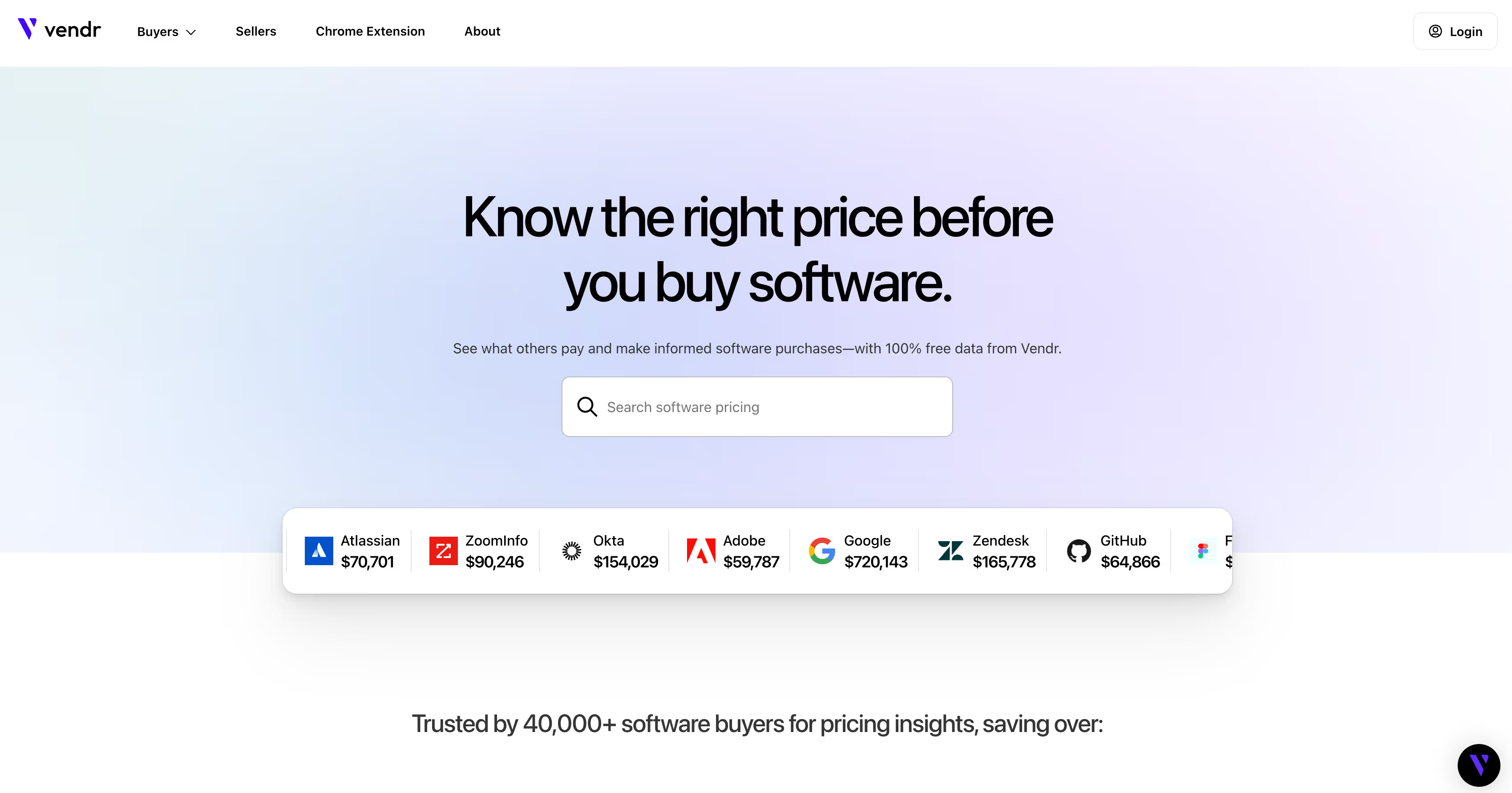
G2 Rating: 4.6/5
Vendr is a unique player in the RFP space, offering a procurement automation platform focused on SaaS buying and vendor management. While not a traditional RFP response tool, Vendr simplifies the RFP issuance process, helping teams source, evaluate, and negotiate software purchases quickly and with data-backed confidence.
Key Features:
- SaaS purchasing automation: Streamlines vendor discovery, evaluation, and negotiation.
- Pre-built RFP templates: Helps teams issue RFPs efficiently for common SaaS categories.
- Benchmarking and pricing intelligence: Leverages anonymized purchasing data to ensure fair pricing.
- Workflow automation: Standardizes legal, security, and procurement reviews across all deals.
- Contract lifecycle visibility: Tracks renewals, approvals, and compliance milestones.
Pros:
- Faster procurement cycles: Greatly reduces the time and effort required to run software RFPs.
- Cost savings: Clients often report 15–25% savings via Vendr’s negotiation insights.
- Procurement-friendly: Built specifically for finance, IT, and ops teams managing software vendors.
Cons:
- Not built for RFP responses: Doesn’t offer tools for responding to RFPs or proposal creation.
- Focuses only on SaaS: Not suitable for hardware, services, or complex project-based RFPs.
Pricing:
Vendr offers custom enterprise pricing based on organization size and volume of SaaS purchasing. Pricing is typically subscription-based and includes:
- Dedicated success managers
- Contract support
- Usage analytics
Best For:
Vendr is ideal for procurement and finance teams looking to issue RFPs and manage SaaS contracts efficiently. It’s best suited for companies scaling their software stacks while seeking visibility, speed, and savings.
13. Ombud

G2 Rating: 4.5/5
Ombud is a content collaboration and automation platform tailored for RFPs, security questionnaires, and sales documents. It focuses on leveraging collective knowledge and automating the response process to reduce friction for subject matter experts and proposal teams alike.
Key Features:
- Dynamic content reuse: Learns from prior responses and updates content suggestions in real time.
- Central knowledge repository: Houses all approved responses, customer messaging, and win themes in one place.
- Auto-response engine: Suggests and drafts content based on question context, product lines, and past submissions.
- Sales document support: Also helps create DDQs, security questionnaires, and statements of work (SOWs).
- Analytics and content health insights: Tracks usage, freshness, and effectiveness of content library items.
Pros:
- Built for cross-functional teams: Designed to support sales, presales, legal, and security teams.
- Clean interface: Easy to navigate with minimal training required.
- Supports multiple document types: Versatile beyond just RFPs.
Cons:
- Limited editing tools: Not as robust in formatting and customization compared to design-focused platforms.
- Best suited for mid-size orgs: May lack some scalability features needed by very large global teams.
Pricing:
Ombud offers custom pricing based on number of users, volume of projects, and document types. Includes:
- Base platform fee
- Content library setup
- Optional integrations with Salesforce, Slack, and Microsoft 365
Best For:
Ombud is ideal for B2B SaaS and tech companies that manage frequent RFPs, security questionnaires, and knowledge-heavy documents. It’s best suited for collaborative teams that want to centralize their content and speed up high-volume responses without deep customization needs.
14. Zbizlink
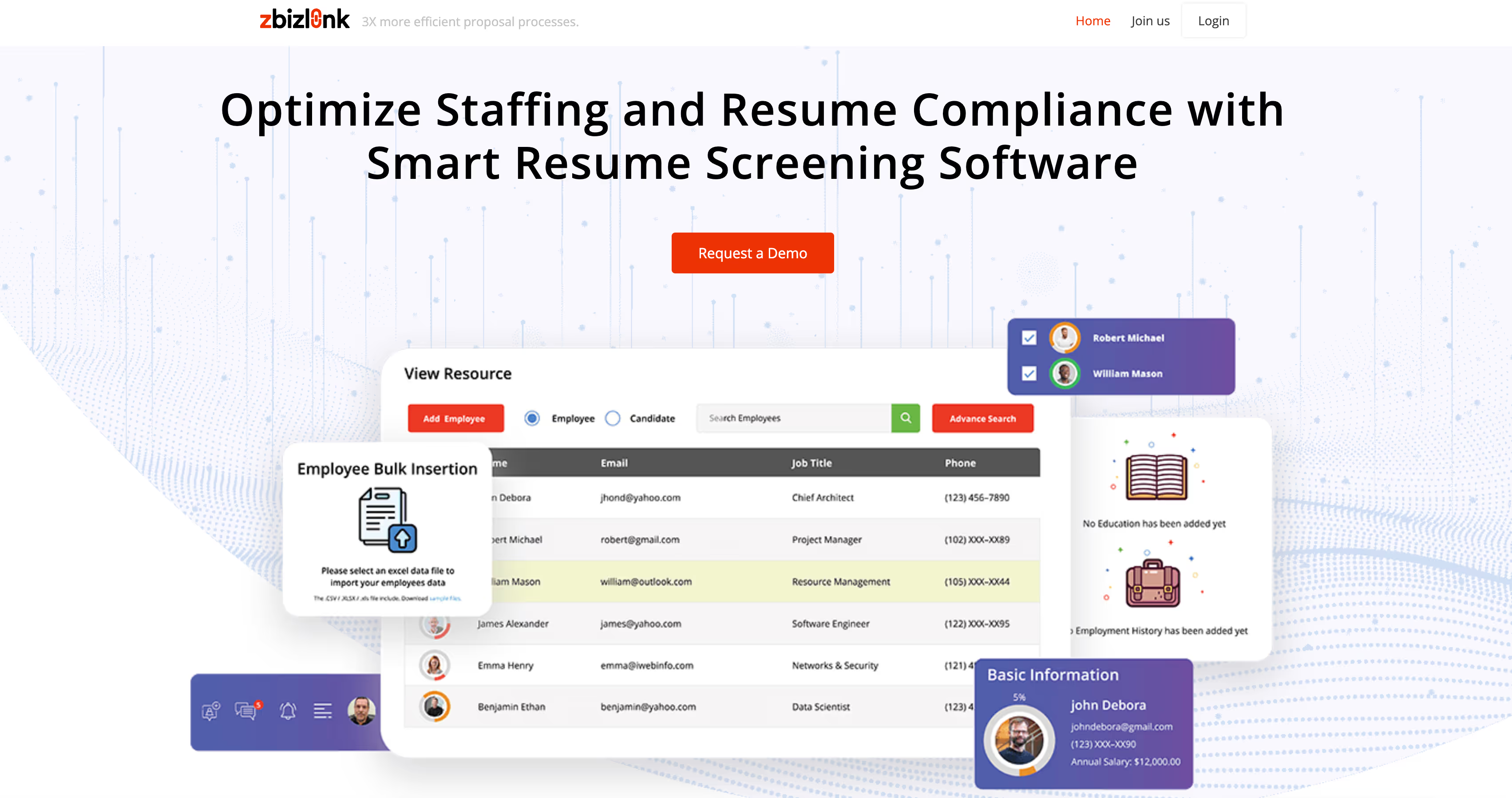
G2 Rating: 4.4/5
Zbizlink is an end-to-end proposal and contract management platform tailored for government contractors and organizations managing complex proposal lifecycles. It offers integrated tools for opportunity tracking, teaming, resume and past performance libraries, and RFP response automation.
Key Features:
- Opportunity tracking: Integrates with government portals like SAM.gov and FedBizOpps to import RFP opportunities.
- Team collaboration: Allows proposal managers, writers, and SMEs to work together with role-based access and task assignments.
- Resume & past performance libraries: Maintains reusable assets tailored for GovCon and proposal compliance.
- Proposal builder: Simplifies response assembly with templates, outlines, and compliance matrices.
- Contract lifecycle support: Tracks awarded contracts, modifications, and deliverables.
Pros:
- GovCon-ready: Specifically designed for government contractors with compliance-driven workflows.
- All-in-one toolset: Combines CRM, content management, and proposal assembly in one solution.
- Affordable for SMBs: Offers pricing tiers accessible to small and mid-sized firms.
Cons:
- Niche focus: Best suited for public sector RFPs—less optimized for commercial or enterprise sales teams.
- UI/UX could be improved: Interface may feel dated compared to newer SaaS platforms.
Pricing:
Zbizlink offers multiple pricing plans with flexible user tiers:
- Standard: Starts at ~$30/user/month for proposal tracking and document management.
- Professional: Adds resume and past performance libraries, plus enhanced templates.
- Enterprise: Includes full automation features and GovCon integrations.
Best For:
Zbizlink is ideal for small to mid-sized government contractors who need a compliance-first, affordable solution to manage proposal workflows across federal, state, and local opportunities.
15. Tribble
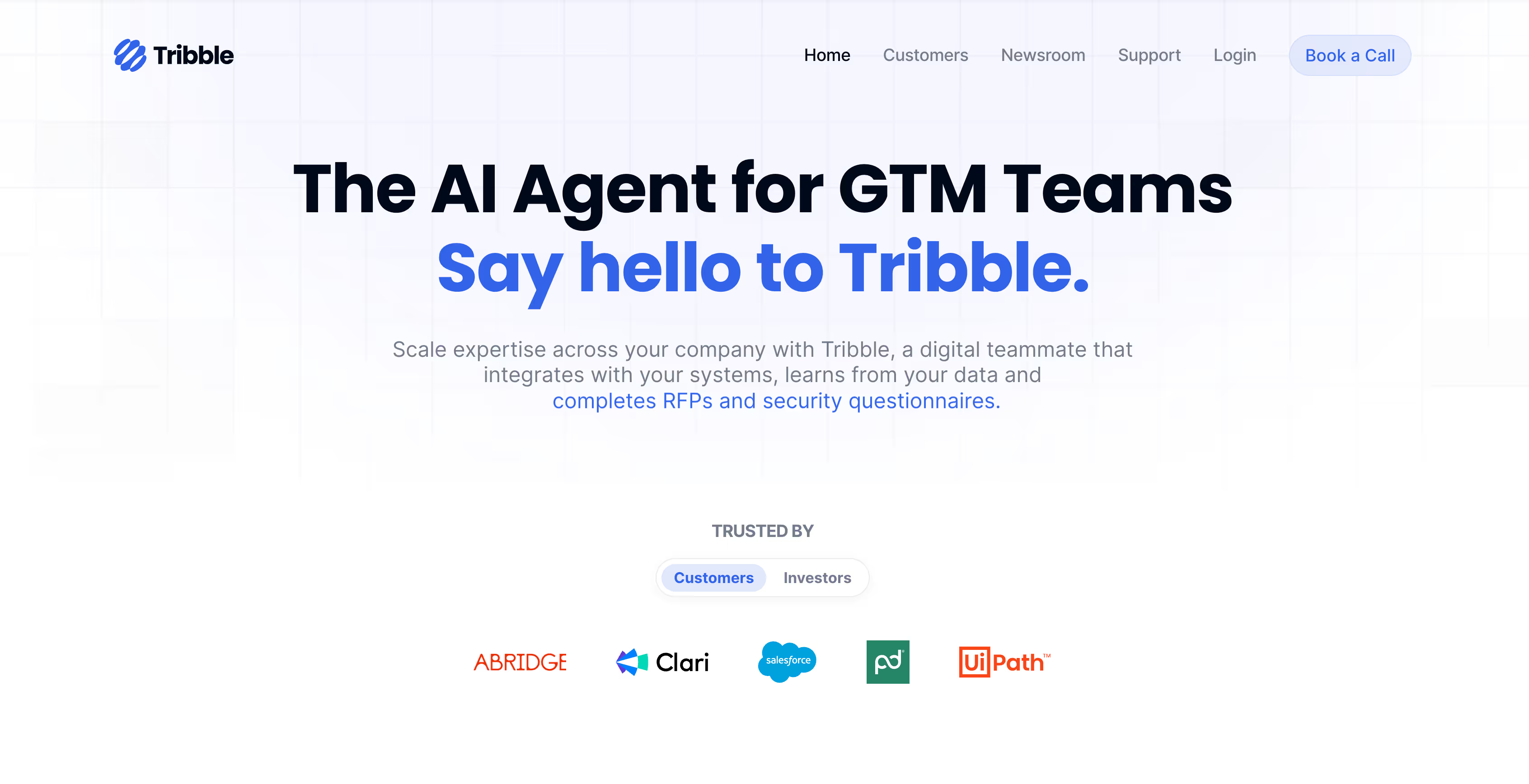
G2 Rating: 4.9/5
Tribble is an AI-powered RFP response platform built for simplicity and speed, delivering highly accurate automated answers by learning from your past responses. It emphasizes fully autonomous RFP completion with minimal manual intervention.
Key Features:
- AI‑driven content automation: Automatically completes RFPs and security questionnaires using intelligent parsing and historical data learning.
- Central knowledge base: Stores approved responses, templates, and industry-specific phrasing for rapid reuse.
- Autonomous RFP handling: Can produce end-to-end responses with a few clicks—users simply review and polish.
- Insightful performance tracking: Offers analytics on success rates, content usage, and response speed.
Pros:
- Exceptional ease of use: Ranked #1 in “Easiest to Use” among RFP tools.
- Time-saving automation: Users report substantial time reduction, often seeing responses completed in minutes.
- Strong AI efficiency: Highly praised for generating accurate, coherent responses quickly.
Cons:
- Newer platform maturity: Being relatively new (founded ~2023), it may have fewer advanced integrations than legacy RFP suites.
- Still scaling features: Lacks some enterprise-level customisation and deep collaboration layers.
Pricing:
Tribble typically offers tiered subscription plans, including:
- Starter: For small teams automating basic RFPs.
- Pro: With advanced analytics and priority AI training.
- Enterprise: Includes custom SLAs, integrations, and onboarding.
Best For:
Ideal for mid-market to enterprise tech firms, professional services, and sales teams needing fast, high-quality AI‑powered RFP completion. Great for users who want maximum output with minimal manual setup.
16. ProposalWorks (by Rockwell Automation)
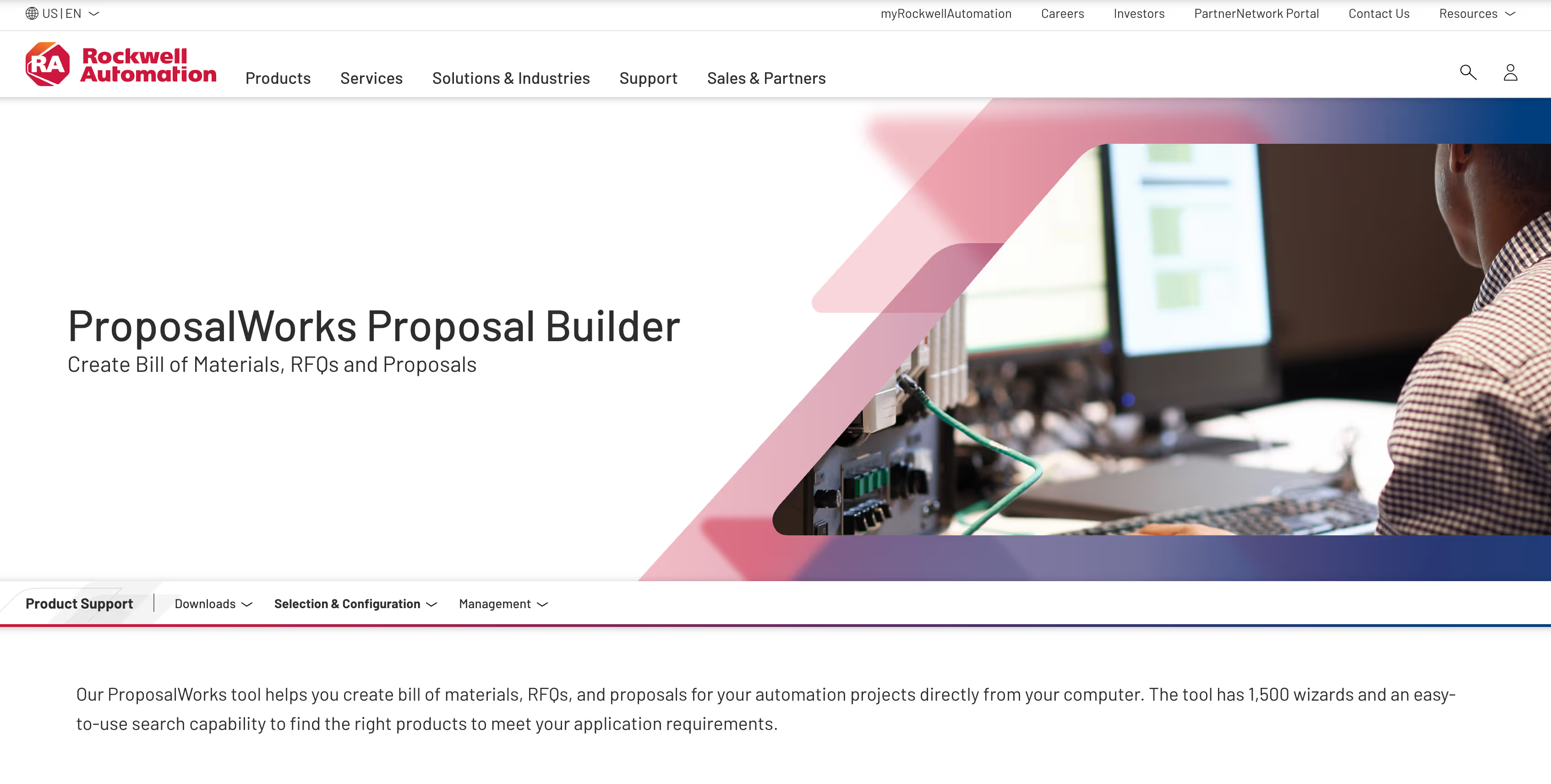
G2 Rating: 4.4/5
ProposalWorks is a robust RFP and quote generation platform designed primarily for engineering, manufacturing, and industrial sectors. It simplifies the process of configuring solutions, generating quotes, and responding to technical RFPs by leveraging product catalogs and spec sheets.
Key Features:
- Product configuration tools: Allows users to configure complex industrial products with built-in validation and export specs directly into proposals.
- Pre-built templates and datasheets: Generate proposals and quotes with consistent branding and regulatory compliance.
- Integration with product selectors: Syncs with Rockwell’s other tools to simplify technical accuracy.
- Offline access: Supports proposal creation in offline mode for field engineers or remote teams.
Pros:
- Excellent for technical responses: Especially strong when proposals require precision on specs, diagrams, and part numbers.
- Great for OEMs and suppliers: Tailored for companies that frequently respond to RFQs and BOMs.
- Zero learning curve for engineers: Interface mirrors product configuration tools engineers already use.
Cons:
- Limited general-purpose RFP features: Not built for SaaS or service-based businesses.
- Niche integrations: Works best inside Rockwell ecosystem; lacks CRM or AI capabilities.
Pricing:
ProposalWorks is free to download and use, but primarily supports organizations that use Rockwell Automation solutions.
Best For:
Best for engineering firms, industrial suppliers, and OEMs responding to technical or product-based RFPs that require part configurations, specs, and branded datasheets. Ideal for users in manufacturing, automation, and utilities.
17. Qwilr
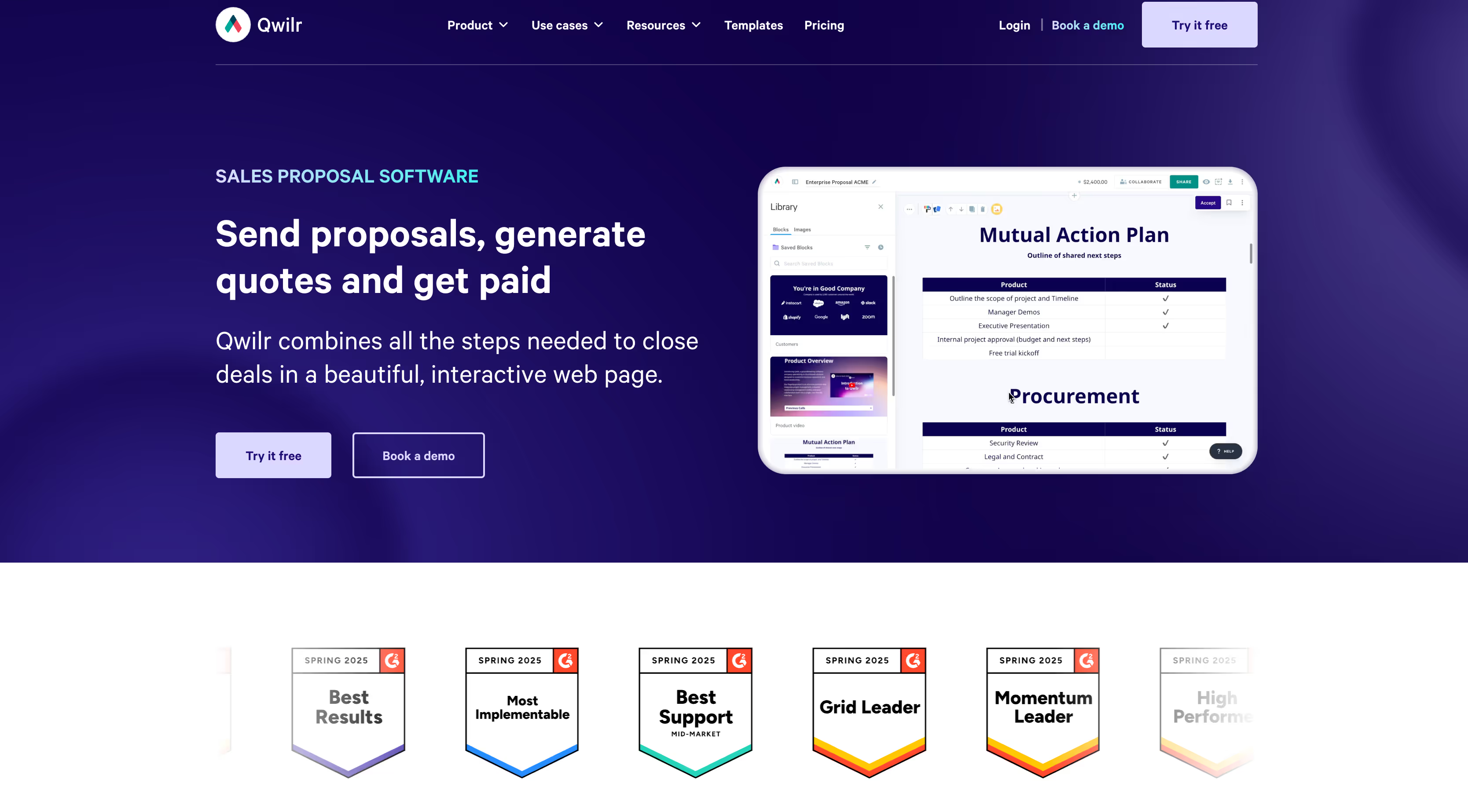
G2 Rating: 4.7/5
Qwilr blends RFP response and proposal design into an elegant, web-based platform that creates interactive, mobile-friendly documents. While not a traditional RFP tool for complex government or security questionnaires, Qwilr excels in sales-driven responses, making it ideal for modern SaaS, marketing, and consulting teams.
Key Features:
- Interactive proposals: Create visually engaging proposals with embedded videos, pricing tables, calendars, and case studies.
- Response templates: Reuse branded, pre-approved content for quicker turnaround.
- Smart quotes & e-signatures: Add interactive pricing and close deals directly from proposals.
- Analytics and notifications: Get alerts when prospects view or interact with proposals.
- CRM integration: Connects with HubSpot, Salesforce, and Pipedrive for seamless pipeline syncing.
Pros:
- High visual impact: Great for differentiating your brand and standing out in competitive RFP processes.
- All-in-one close tool: Combines proposal, quote, contract, and signature into one document.
- Fast deployment: Minimal setup; teams can start building documents within hours.
Cons:
- Not built for formal RFP compliance: Lacks response matrices or complex workflow handling.
- Limited content intelligence: Doesn’t offer AI-generated suggestions or large knowledge bases.
Pricing:
Qwilr offers tiered SaaS pricing, billed annually:
- Business: $35/user/month – branded templates, analytics, and e-signatures.
- Enterprise: Custom pricing – includes API, single sign-on (SSO), and audit logs.
Best For:
Qwilr is ideal for growth-stage SaaS, marketing agencies, and B2B service firms that prioritize visual storytelling and want a fast, modern way to respond to lightweight RFPs or client proposals with flair.
18. AutogenAI

G2 Rating: 4.5/5
AutogenAI is an AI-powered RFP response assistant that helps teams rapidly draft detailed and accurate RFPs, especially suited for consulting and facilities services sectors.
Key Features:
- Automated drafting: AI generates first-pass responses based on context, saving significant time.
- Template & content management: Store reusable content and standard templates for quick deployment.
- Efficiency tracking: Pros report improved workflow efficiency and time savings.
Pros:
- Time-saving: Identified as “Time‑saving” and “Efficiency” are noted pros by real users.
- Good customer support: Received praise for responsive service and support.
- Smart AI assistance: Strong AI engine significantly speeds up the drafting process .
Cons:
- Learning curve: Some users mention it could be more intuitive initially .
- UI/UX polishing: A few users suggest improvements needed in interface design.
Pricing:
While exact pricing isn’t listed on G2, the platform’s entry-level packages typically include a base subscription with AI drafting and core features. Higher tiers add advanced templates, analytics, and premium support.
Best For:
Great choice for mid-market to enterprise teams in consulting, professional services, and facilities who want to automate most of the RFP process with smart AI drafting backed by solid support.
19. RocketDocs
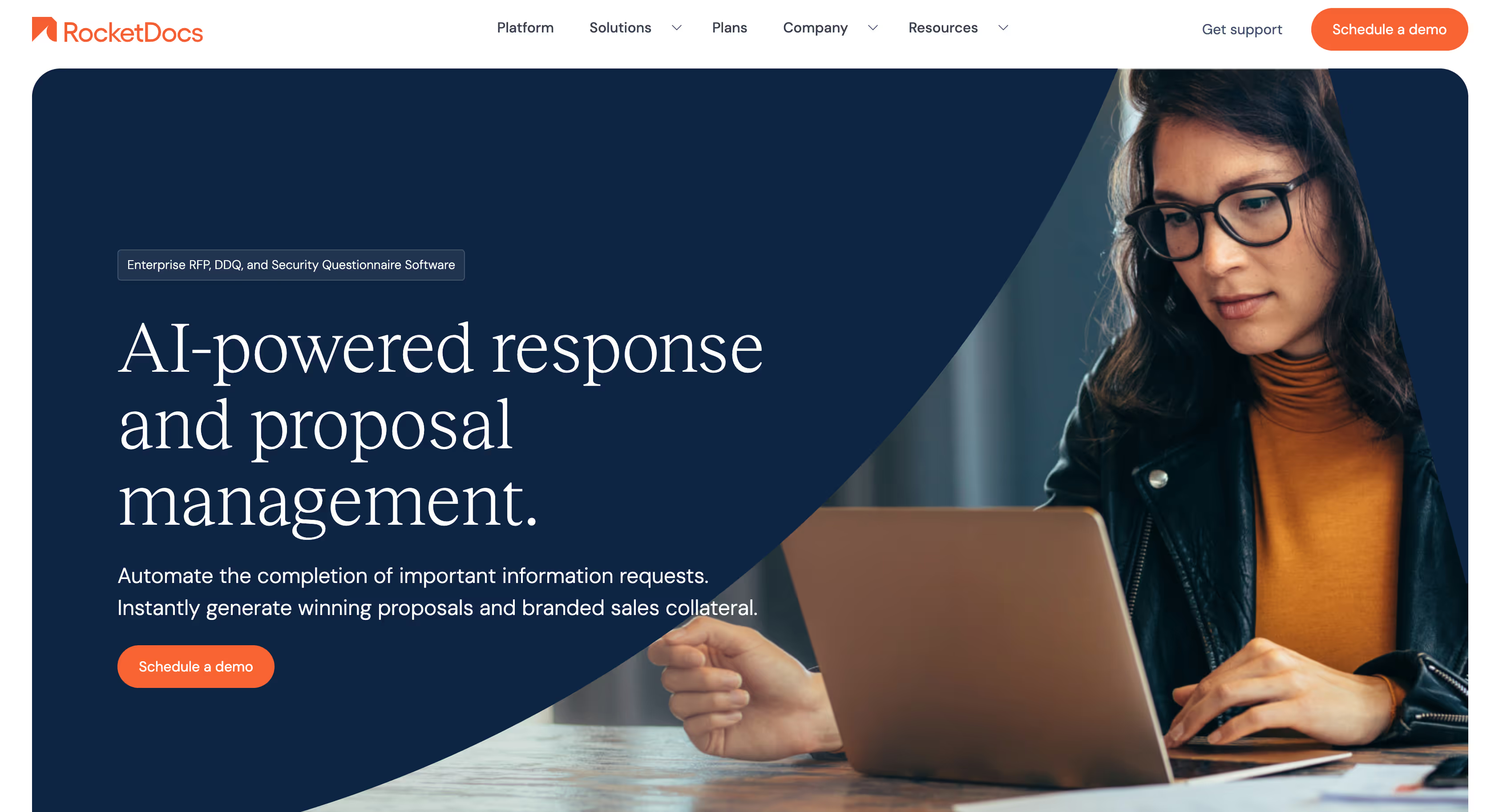
G2 Rating: 4.2/5
RocketDocs is a document and RFP response automation platform designed for financial services and investment management teams looking to streamline due diligence, RFPs, and security questionnaires.
Key Features:
- Unified automation platform: Powered by private AI to generate drafts, auto-populate responses, and assemble high-quality documents.
- Document & content management: Stores and reuses approved content blocks and templates across proposals .
- Collaboration tools: Workflow tracking for assignments, reviews, and version control.
Pros:
- Industry-specific strong suit: Particularly suited to financial services and investment management firms.
- Boosts consistency: Helps maintain brand-aligned, compliant responses at scale .
- Private AI ensures security: Built with data control and compliance in mind.
Cons:
- Learning curve: Some users report a steeper initial setup and onboarding phase .
- Core with manual workflow: Although automated, some processes still rely on manual review steps .
Pricing:
- Custom enterprise pricing — details typically provided via vendor consultation.
Best For:
Ideal for mid-market to enterprise financial firms managing RFPs, due diligence questionnaires, and compliance documentation, especially when private AI security is essential.
20. XaitCPQ (formerly BlueprintCPQ)
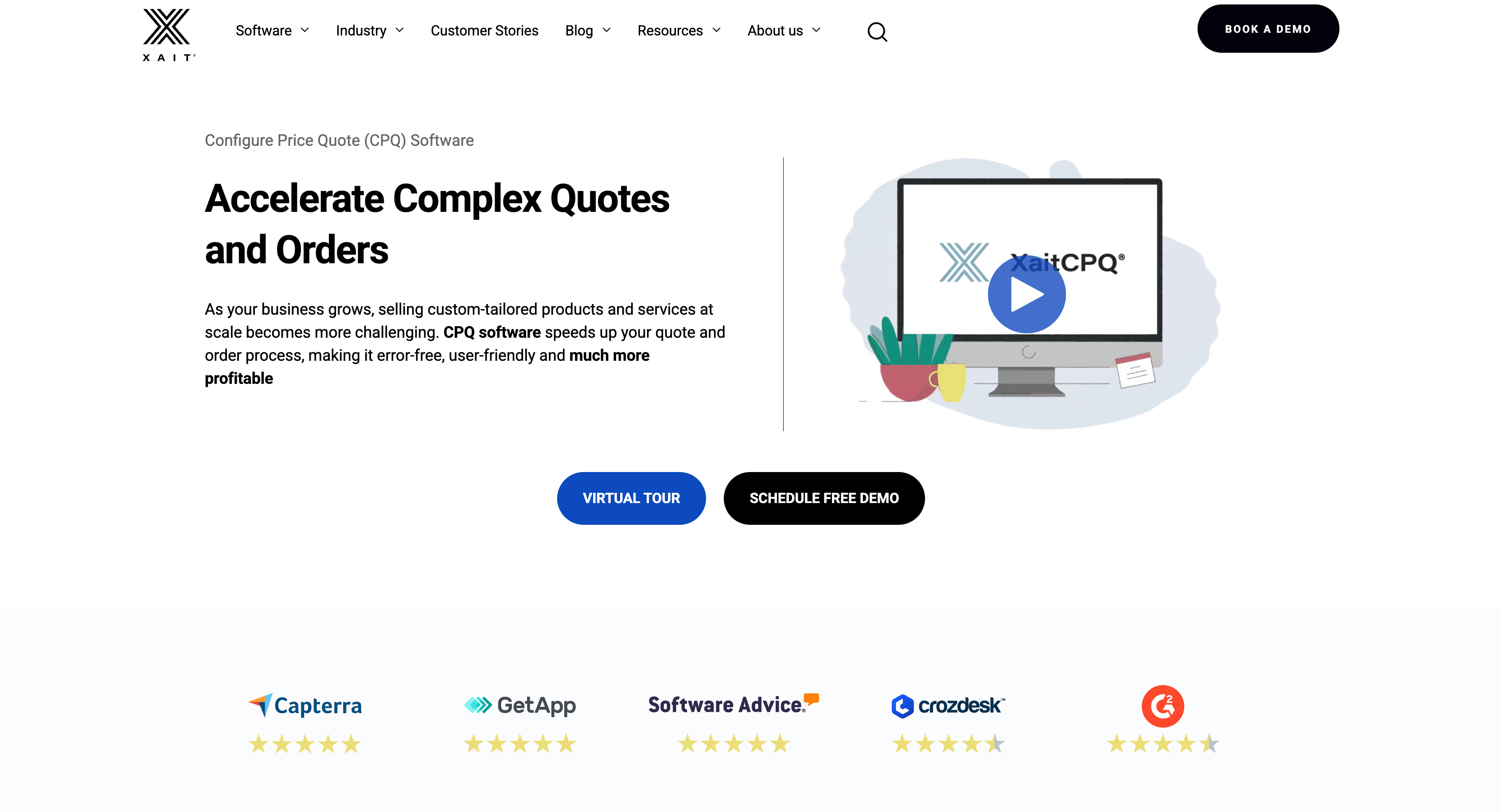
G2 Rating: 4.3/5
XaitCPQ is a robust CPQ + RFP response platform designed for complex B2B sales involving technical configurations and proposals. Now part of the Xait product suite, it blends RFP automation with configure–price–quote (CPQ) capabilities, making it ideal for manufacturing, engineering, and high-tech industries.
Key Features:
- CPQ + proposal automation: Generate technically accurate proposals from product configurations in real time.
- Template-driven RFP output: Automatically builds branded, compliant proposals with technical detail.
- Integrated pricing logic: Embeds discount rules, margin controls, and approval workflows.
- Multi-language support: Helps international sales teams generate proposals in various markets.
- Workflow automation: Assigns reviewers, tracks deadlines, and ensures version control throughout.
Pros:
- Perfect for technical RFPs: Combines engineering data with sales proposals seamlessly.
- Sales + ops alignment: Reduces friction between sales teams and product experts.
- Strong document consistency: Eliminates manual errors and ensures brand-aligned output.
Cons:
- Not for simple RFPs: Overkill for service-based or lightweight commercial proposals.
- Initial setup complexity: Requires time and technical input to configure product rules.
Pricing:
XaitCPQ uses custom enterprise pricing, typically based on:
- Number of users
- Product complexity
- Region/language needs
- Integration scope
Best For:
XaitCPQ is ideal for industrial, engineering, or tech companies handling complex RFPs tied to product configurations, pricing logic, and multilingual document delivery. Great for companies that want to connect product, pricing, and proposals in one system.
21. ProcurePort RFP Software
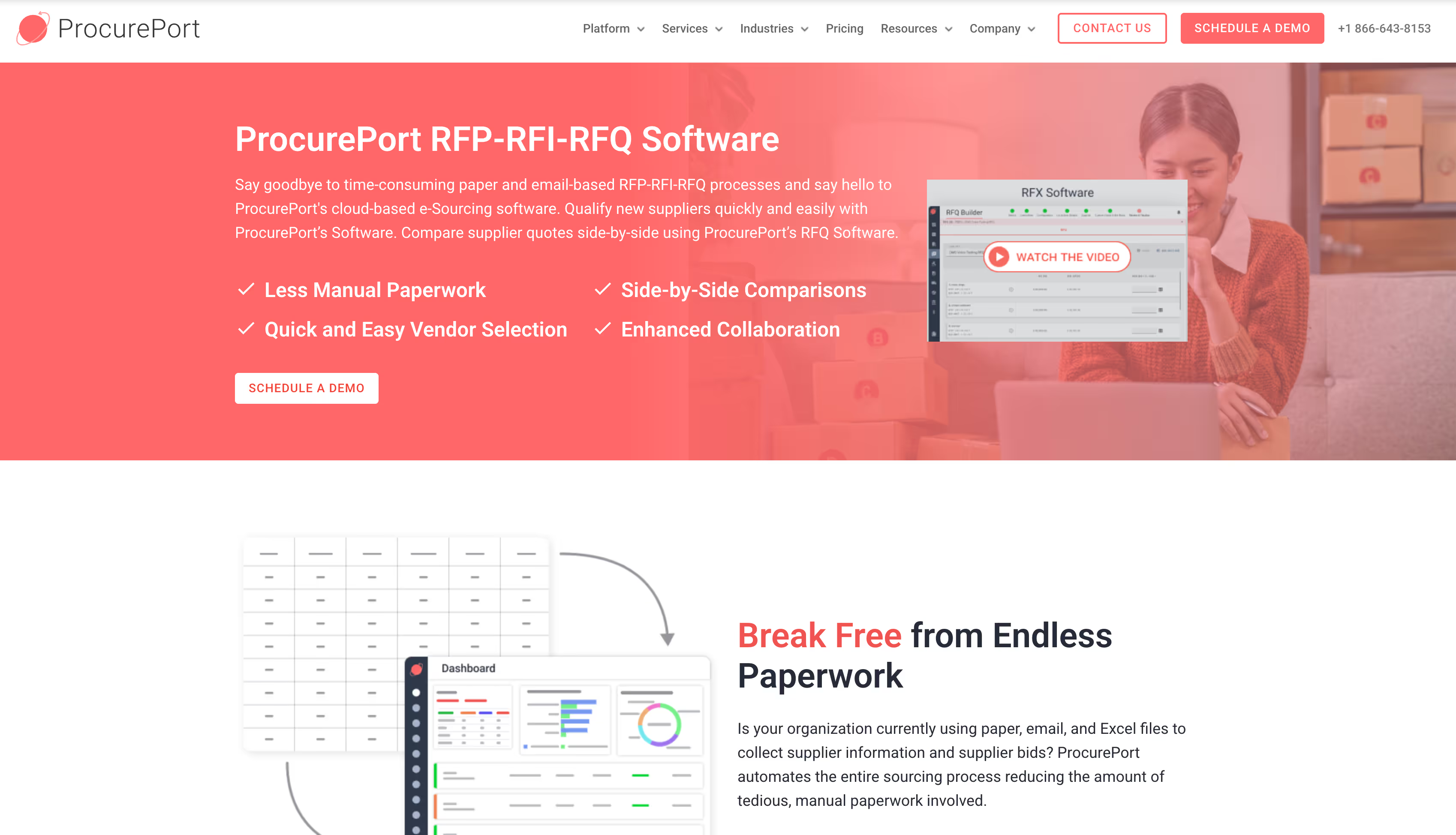
G2 Rating: 4.4/5
ProcurePort offers a full-suite e-sourcing platform, with a dedicated RFP management module tailored for procurement and vendor selection teams. While it's more procurement-focused than sales response, it’s widely used for automating vendor RFPs with scoring, collaboration, and compliance support.
Key Features:
- RFP creation & issuance tools: Build detailed RFPs with custom scoring, timelines, and stakeholder access.
- Vendor response tracking: Centralized dashboard to manage submissions, clarifications, and deadlines.
- Automated evaluation & scoring: Enables fair, multi-user evaluation with weighted criteria and audit trails.
- Document management & attachments: Easily manage large files and proposal documentation.
- e-Sourcing suite integration: Works alongside RFQ, reverse auction, and contract modules.
Pros:
- Strong in procurement workflows: Ideal for sourcing, vendor onboarding, and supplier assessments.
- Built-in compliance tracking: Great for regulated sectors needing full documentation trails.
- Supports large RFPs: Handles high-volume, multi-vendor RFPs efficiently.
Cons:
- Not designed for sales teams: Lacks AI response generation or proposal branding features.
- Interface is utility-first: Functional but not as visually refined as modern SaaS tools.
Pricing:
ProcurePort offers modular pricing — you pay for what you need:
- Entry-level RFP module for small teams
- Enterprise plans with full e-sourcing capabilities
- Custom pricing based on project volume and user roles
Best For:
Best for procurement and sourcing teams in manufacturing, government, healthcare, and education sectors that manage complex vendor RFPs, where scoring, compliance, and documentation are critical.
22. Olive
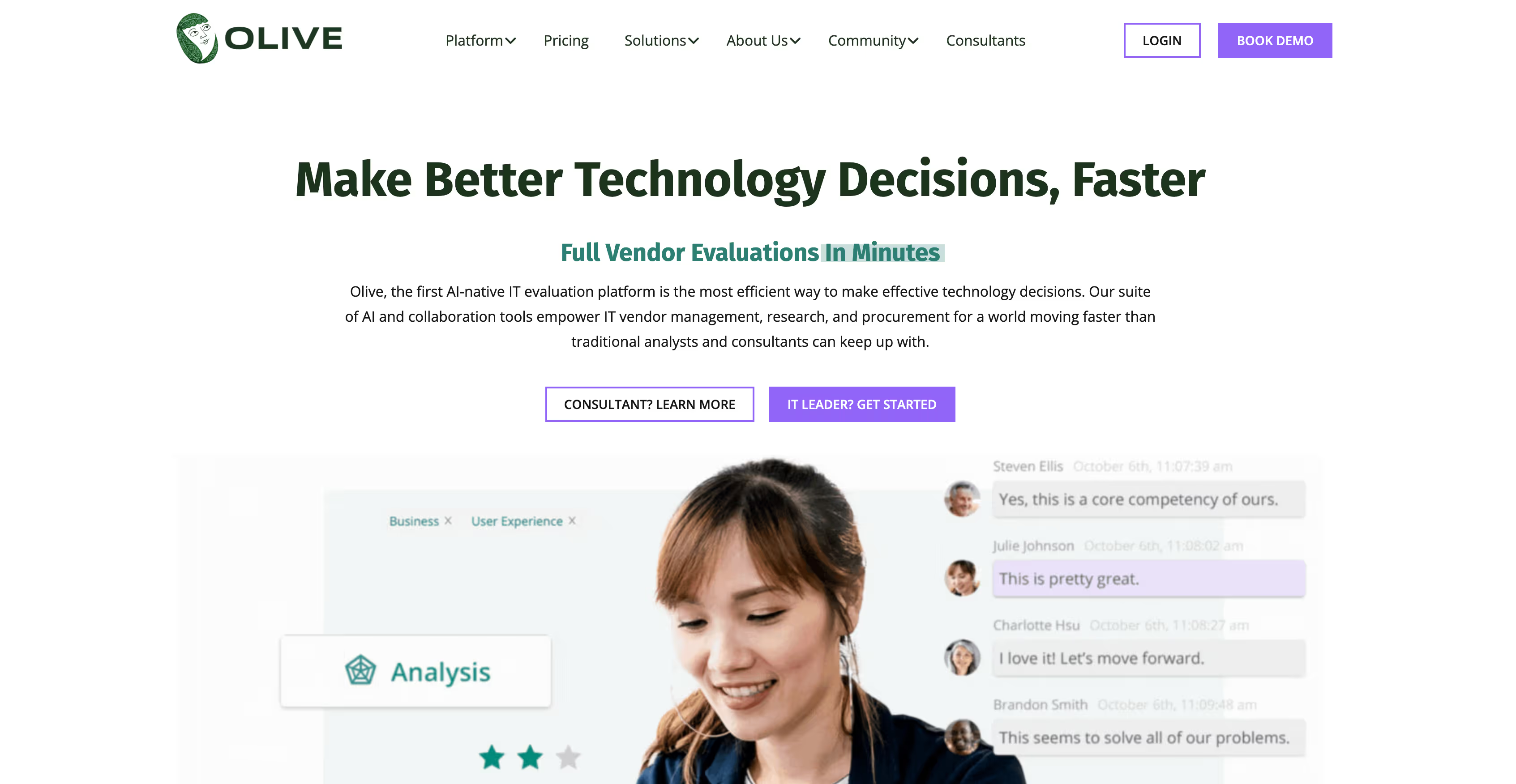
G2 Rating: 4.4/5
Olive is an AI-powered platform designed to accelerate RFP creation and management—particularly for IT leaders and mid-market to enterprise procurement teams. It’s praised for its ease of use and efficiency in generating RFX documents quickly .
Key Features:
- Rapid RFP document generation: AI helps build structured questionnaires and standardized templates.
- Intuitive RFP management: Users highlight Olive’s simplicity and interface clarity .
- Vendor response tracking: Helps manage timelines, clarifications, and submissions.
- Efficiency tools: Designed to streamline sourcing processes with minimal setup and training.
Pros:
- Ease of use: Frequently noted for being intuitive and straightforward .
- Time-saving: Users highlight quick setup and rapid RFP creation.
- Mid-market/enterprise fit: Strong adoption by IT and procurement teams.
Cons:
- Minimal customization: Some report limitations in tailoring beyond basic templates.
- Vendor-side capabilities missing: Focuses on RFP issuance, not response automation.
Pricing:
Olive typically offers modular, tiered pricing with entry-level plans geared toward mid-market, though exact figures require vendor contact .
Best For:
Best suited for IT procurement and sourcing teams that need to create and distribute RFPs quickly with a clean interface and efficient workflow—especially in mid-market settings.
23. MyRequest (by Proposal Point)

G2 Rating: 4.5/5
MyRequest is a specialized RFP intake and response coordination tool built to help organizations centralize, qualify, and assign RFPs quickly. It acts as a front-end workflow layer to manage inbound proposal requests before pushing them into full RFP response platforms like Loopio or Responsive.
Key Features:
- RFP intake form builder: Standardizes how teams receive RFPs from internal or external stakeholders.
- Qualification scoring: Helps triage which opportunities are worth pursuing.
- Assignment workflows: Automatically routes requests to the right teams or SMEs based on tags and volume.
- Real-time dashboards: Tracks open, qualified, declined, and completed RFPs with visual status cues.
- Integrations: Works with common RFP platforms, CRMs, and messaging tools like Slack or MS Teams.
Pros:
- Fills a common process gap: Helps teams get organized before even opening the RFP.
- Accelerates go/no-go decisions: Increases win-rate focus by qualifying only strong-fit RFPs.
- Simple, lightweight UI: Minimal setup, fast adoption for distributed teams.
Cons:
- Not a full RFP responder: Meant to manage intake and assignment, not actual content creation.
- Works best as a companion tool: Adds most value when integrated with a Loopio/Responsive-style system.
Pricing:
MyRequest offers affordable, user-based pricing — typically starting around $25–$35/user/month, with custom pricing for larger organizations.
Best For:
Ideal for mid-sized to large organizations that deal with high RFP volumes and need to qualify and prioritize proposals efficiently before assigning them to response teams.
24. SalesEdge

G2 Rating: 4.6/5
SalesEdge is a proposal and RFP automation platform focused on content-driven sales enablement, built especially for B2B teams in tech, manufacturing, and financial services. It blends document automation with structured RFP response workflows and integrates closely with CRMs and content libraries.
Key Features:
- Smart content repository: Houses approved answers, product data, and sales collateral for fast RFP response reuse.
- Guided workflows: Assists proposal teams through structured steps for intake, response, review, and submission.
- Salesforce integration: Pulls data directly from CRM records to populate proposals.
- Custom templates & branding: Ensures consistency across all client-facing documents.
- Real-time collaboration: Includes assignment tracking, version control, and deadline alerts.
Pros:
- Sales-focused proposal tool: Great fit for teams combining proactive proposals with RFPs.
- Strong customer support: Highly rated for onboarding and responsive help.
- Flexible for complex teams: Handles multiple business units, regions, and verticals well.
Cons:
- Limited AI capabilities: Not as automation-heavy as newer AI-first platforms.
- Best with Salesforce: Maximum value is achieved when deeply integrated with CRM.
Pricing:
SalesEdge offers custom pricing, typically based on:
- Number of users
- Template complexity
- CRM integrations
Plans start with core RFP and proposal workflows, with enterprise add-ons for analytics and multi-brand support.
Best For:
Perfect for B2B sales and marketing teams that produce high volumes of proposals and RFP responses while maintaining strict content consistency, brand control, and CRM alignment.
25. Tomorro
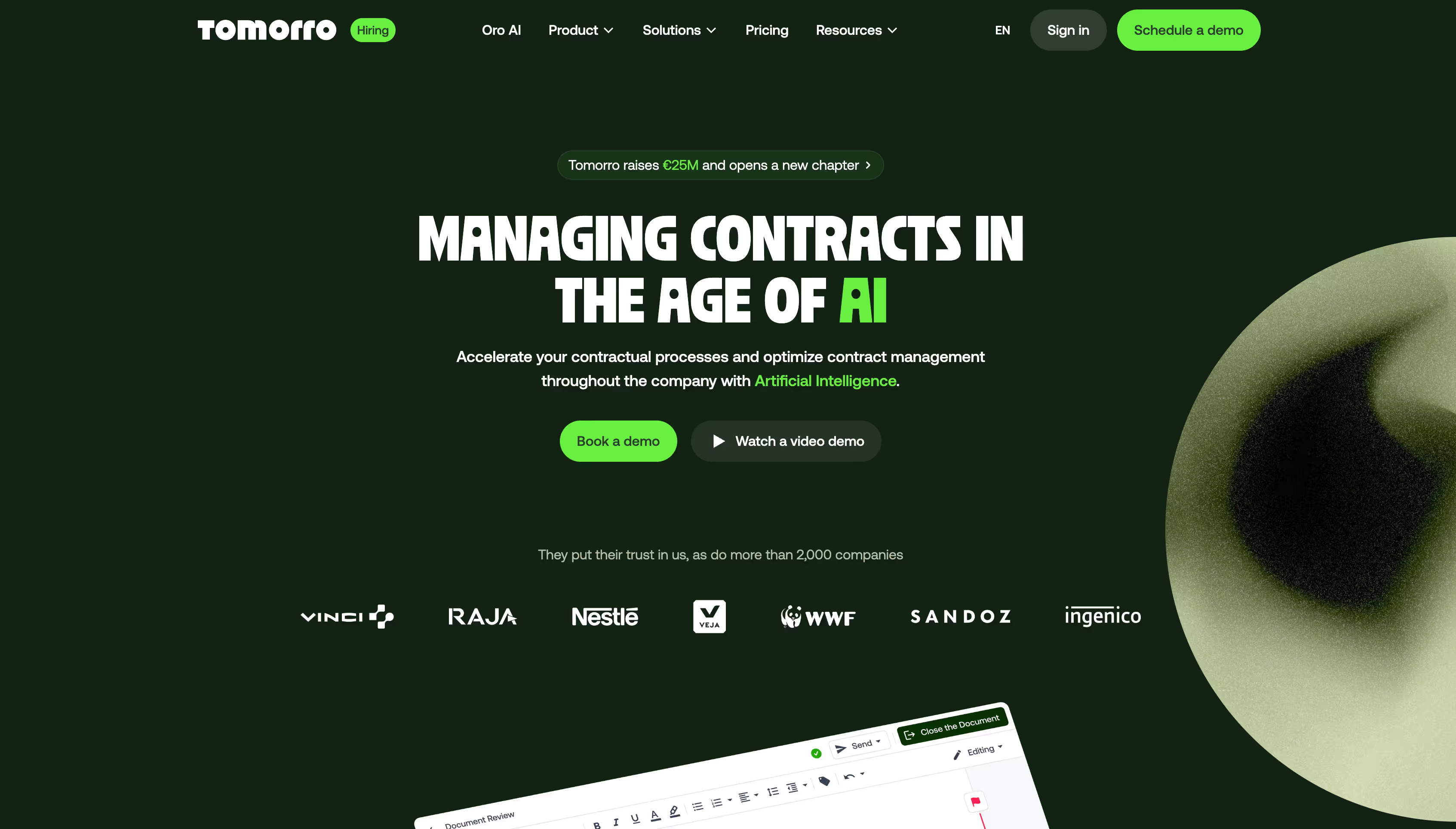
G2 Rating: 4.3/5
Tomorro, formerly known as DeepRFP, is an AI-native RFP automation platform designed to help enterprise teams analyze, respond, and manage large-scale RFPs, security questionnaires, and due diligence documents faster and with higher precision.
Key Features:
- RFP opportunity analyzer: Automatically scans RFP documents and highlights risks, opportunities, and resource needs.
- Auto-response engine: Uses machine learning to recommend contextually relevant responses based on past submissions.
- Smart collaboration tools: Supports team-wide reviews, roles, deadlines, and task tracking.
- Response quality scoring: Predicts the strength of each draft answer using internal benchmarks and best practices.
- Security & compliance modules: Includes NDA tracking, redline management, and internal audit logs.
Pros:
- Enterprise-grade AI: Designed for global companies managing hundreds of RFPs and security reviews annually.
- Detailed risk analysis: Helps assess fit and competitive viability before investing resources.
- Full response lifecycle: Supports teams from RFP intake to final approval and audit trails.
Cons:
- Steep learning curve: Rich feature set may overwhelm smaller or non-technical teams.
- Higher-tier pricing: Aimed at enterprises with structured RFP teams and compliance mandates.
Pricing:
Tomorro offers custom enterprise pricing. Typical packages include:
- AI engine + knowledge base
- Review workflows + response scoring
- SLA-based onboarding and support
Best For:
Tomorro is ideal for large enterprises, consulting firms, and compliance-heavy industries that need to quickly assess, prioritize, and complete complex RFPs using AI, governance, and collaboration at scale.
What to Look for in RFP Software?
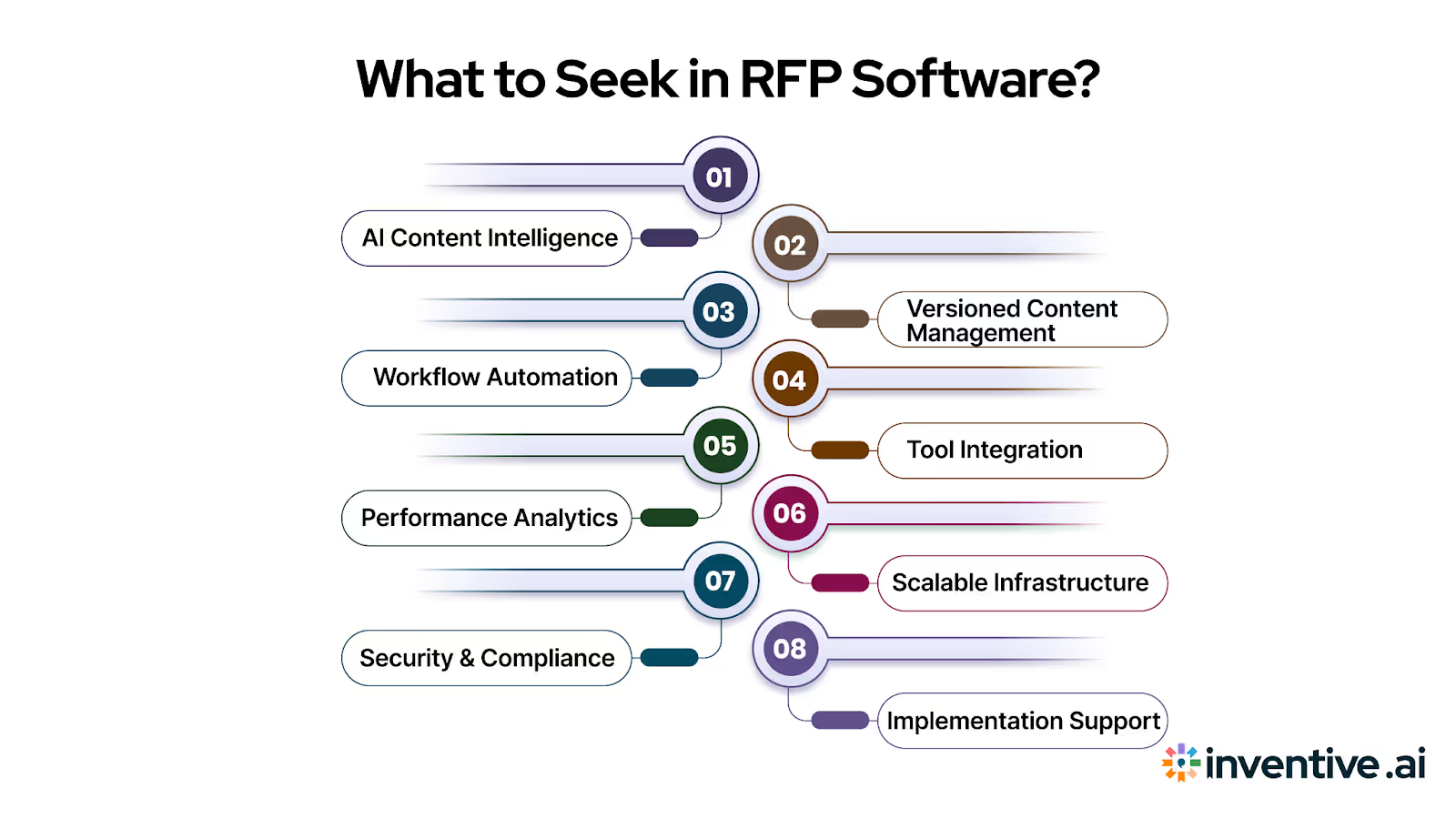
While evaluating RFP software, it’s essential to focus on capabilities that directly impact your deal velocity and win rates. Here are some of the top factors to consider while choosing the right software:
- AI-Powered Content Intelligence beyond Keyword Matching
Look for systems that understand context and intent. For instance, when an RFP asks about "system reliability," the platform should recognize that your "uptime commitments," and "performance monitoring" content all address this requirement. Basic keyword systems miss these connections and forces you to manually search content.
- Content Management with Version Control and Conflict Detection
Your system should automatically identify when different team members create conflicting responses to similar questions. Advanced platforms flag inconsistencies before they appear in proposals. For instance, if your sales team says "99.9% uptime" while engineering says "99.5% uptime," the system should alert you to resolve the discrepancy.
- Workflow Automation that Removes Manual Bottlenecks
Evaluate how the system handles approvals and reviews. Look for platforms that automatically route technical questions to engineering, compliance questions to legal, and pricing questions to finance. Manual assignment creates delays and missed deadlines.
- Integration Architecture that Works with Your Existing Tools
The platform should connect seamlessly with your CRM, document storage, and communication systems. If you use Salesforce for opportunity management, the system should automatically pull customer information and update deal status. Avoid platforms that require manual data entry or duplicate workflows.
- Performance Analytics that Identify Improvement Opportunities
Your system should track which responses win deals and which lose. Look for platforms that provide insights like "responses mentioning specific ROI metrics win 40% more often" or "technical responses longer than 200 words have lower success rates." This data helps you continuously improve your competitive positioning.
- Scalability Infrastructure for Growth
Consider your anticipated proposal volume over the next 2-3 years. The platform should handle increased activity without performance degradation. Look for systems that support multiple business units, geographic regions, and product lines without requiring separate instances.
- Security and Compliance Capabilities
Evaluate encryption standards, access controls, and audit trails. The system should provide detailed logs of who accessed what information and when. For regulated industries, look for platforms with specific compliance certifications relevant to your requirements.
- Implementation Methodology and Support
The vendor should provide structured onboarding, comprehensive training, and ongoing optimization support. Avoid platforms that require extensive IT involvement or lengthy setup periods. Look for solutions that demonstrate quick time-to-value with minimal disruption to existing processes.
Once you're aware of the selection criteria, choosing the right RFP software solutions becomes easier.
How to Pick the Best RFP Software?
Your RFP software selection determines whether you gain competitive advantage or add operational complexity. Revenue leaders must evaluate platforms based on measurable business outcomes rather than feature demonstrations.
The systematic evaluation should prioritize these critical decision factors:
- Current process cost analysis: Document where your team spends time during proposal creation and identify the highest-impact automation opportunities.
- Integration compatibility assessment: Test how the platform connects with your existing CRM, document management, and approval workflows to avoid creating duplicate processes.
- Content intelligence capability: Evaluate how effectively the system understands context and generates relevant responses rather than basic keyword matching.
- Vendor implementation methodology: Review the vendor's track record for on-time implementations and their ability to provide ongoing optimization support.
- Total cost of ownership calculation: Include licensing, implementation, training, and opportunity costs to compare against expected value from automation.
This evaluation approach ensures you select a solution that delivers measurable ROI rather than just impressive demonstrations.
Looking for a comprehensive evaluation framework? Check out our 7-step buying guide for AI-driven RFP software to make an informed decision.
Before implementing any solution, it's also worth looking at the specific problems your team faces regularly so that you can understand the automation needs better.
Common Challenges RFP Response Teams Face
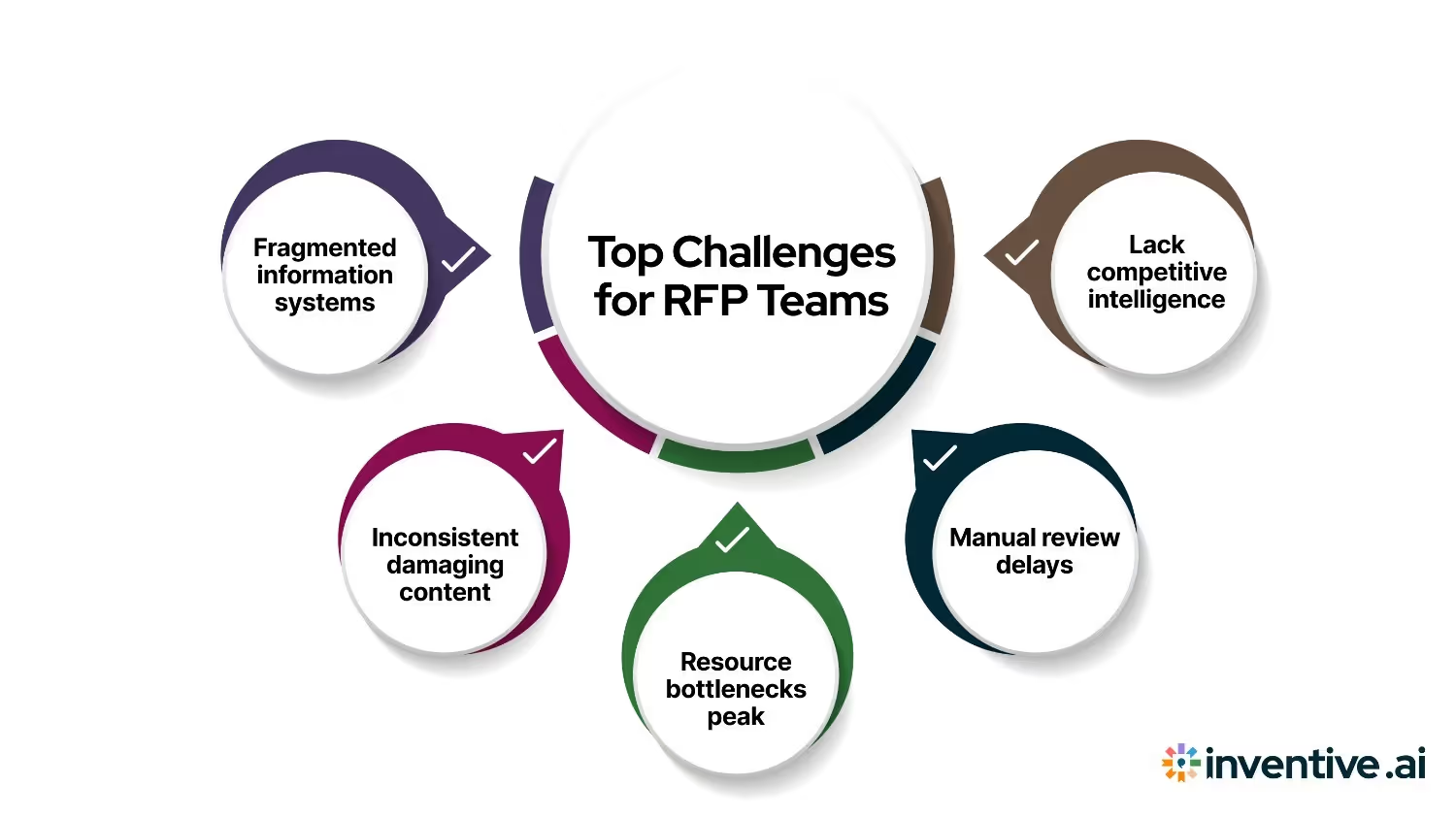
Manual RFP processes create systematic inefficiencies that compound over time, directly impacting your ability to compete effectively. These operational problems prevent teams from pursuing winnable opportunities and reduce the quality of submitted proposals.
The most critical operational challenges that automation addresses include:
- Information fragmentation across disconnected systems: Teams search through scattered content repositories instead of focusing on strategic differentiation and customer-specific positioning.
- Content inconsistency that damages credibility: Different team members create conflicting responses to similar questions, confusing evaluators and weakening your competitive positioning.
- Resource allocation bottlenecks during peak periods: Subject matter experts become overwhelmed when multiple opportunities compete for their input simultaneously.
- Manual review cycles that create submission delays: Email-based approval processes lose track of feedback and create last-minute scrambles to meet deadlines.
- Absence of competitive intelligence for strategic positioning: Teams recreate responses without understanding which approaches have succeeded previously against specific competitors.
Gartner forecasts that 95% of sales research will start with AI by 2027, rising from under 20% in 2024, making automated processes essential for staying ahead of competitors. Let’s look at how RFP software solves these challenges and helps you automate your RFP response processes.
How RFP Software Helps In Improving Your Response Processes?
RFP software creates measurable operational improvements that directly impact your competitive position and revenue generation capability. Organizations see immediate improvements in response speed and proposal quality upon implementation.
The transformation delivers these specific business outcomes:
While most RFP software offer basic automation benefits, some platforms like Inventive AI come with advanced automation capabilities.
Why Choose Inventive AI Over Other RFP Software?
Inventive AI delivers advanced AI capabilities specifically designed for competitive advantage. The platform goes beyond content retrieval to provide strategic intelligence that directly impacts win rates.
Here's how Inventive AI compares to other solutions in critical capability areas:
Inventive AI transforms your RFP process with specialized capabilities that deliver measurable improvements in both speed and win rates while providing strategic advantages that compound over time.
Final Thoughts
The RFP software market in 2025 offers powerful solutions for teams struggling with manual proposal processes. From comprehensive platforms like Loopio and Responsive to specialized AI-powered solutions like Inventive AI, there's a tool for every organization's needs and budget.
It is important to choose a platform that aligns with your team's specific requirements, existing workflows, and growth objectives. Consider factors like AI capabilities, integration needs, and implementation timeline when making your decision.
For teams seeking the most advanced AI-powered RFP automation, Inventive AI offers unmatched capabilities in competitive intelligence, content management, and strategic proposal development.
FAQs
1. What is the average cost of RFP software in 2025?
RFP software pricing ranges from $300/month for basic plans to custom enterprise solutions. Most mid-market solutions cost between $1,000-$5,000 monthly depending on features and team size.
2. How long does it take to implement RFP software?
Implementation typically takes 2-8 weeks depending on complexity. AI-powered solutions often deploy faster due to minimal configuration requirements.
3. Can RFP software integrate with existing CRM systems?
Yes, most modern RFP software integrates with popular CRM platforms like Salesforce, HubSpot, and Microsoft Dynamics. This ensures seamless data flow between sales and proposal processes.
4. How does AI improve RFP response quality?
AI analyzes requirements, suggests relevant content, and generates contextually appropriate responses. Advanced platforms also provide competitive intelligence and strategic recommendations for better positioning.


